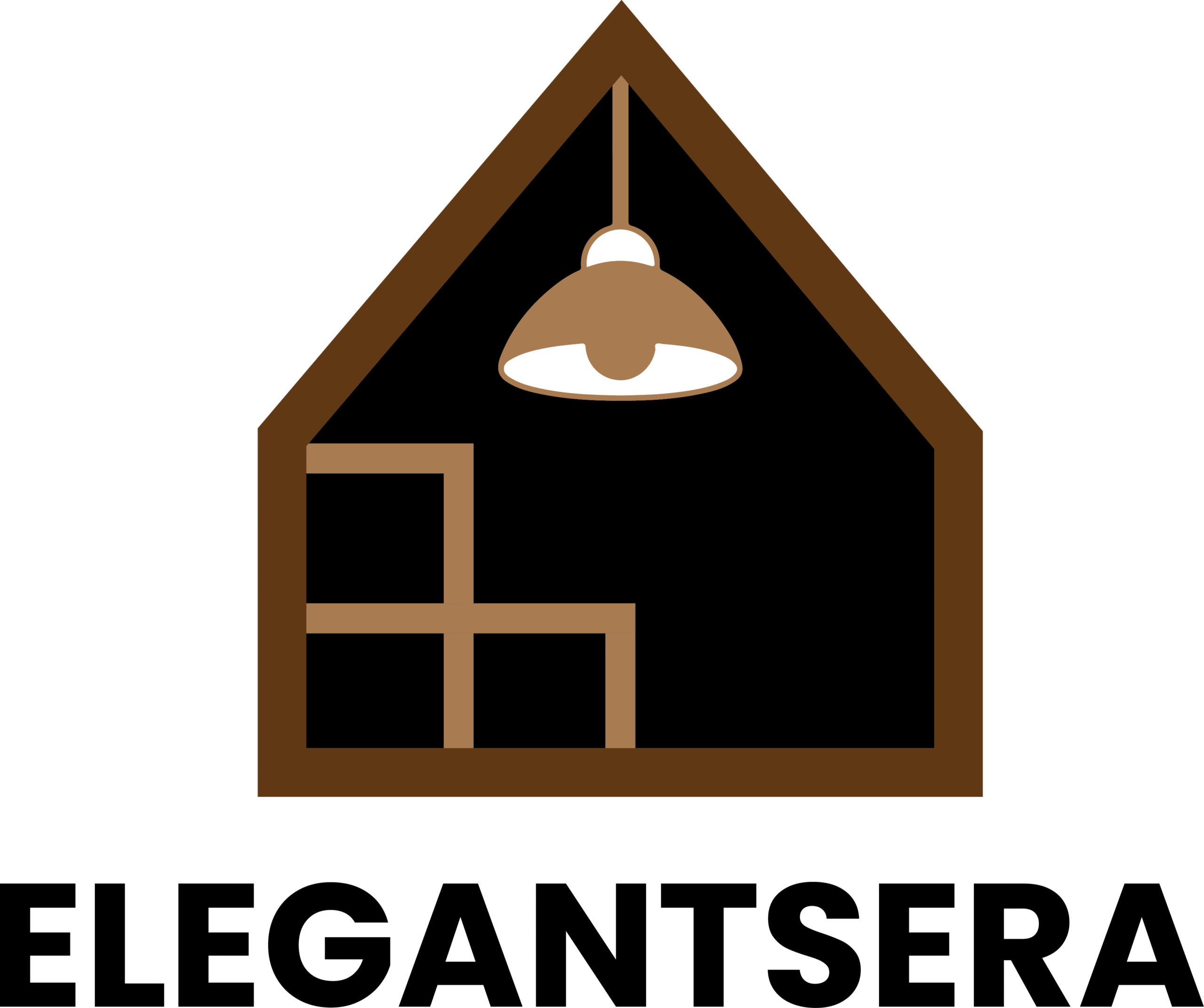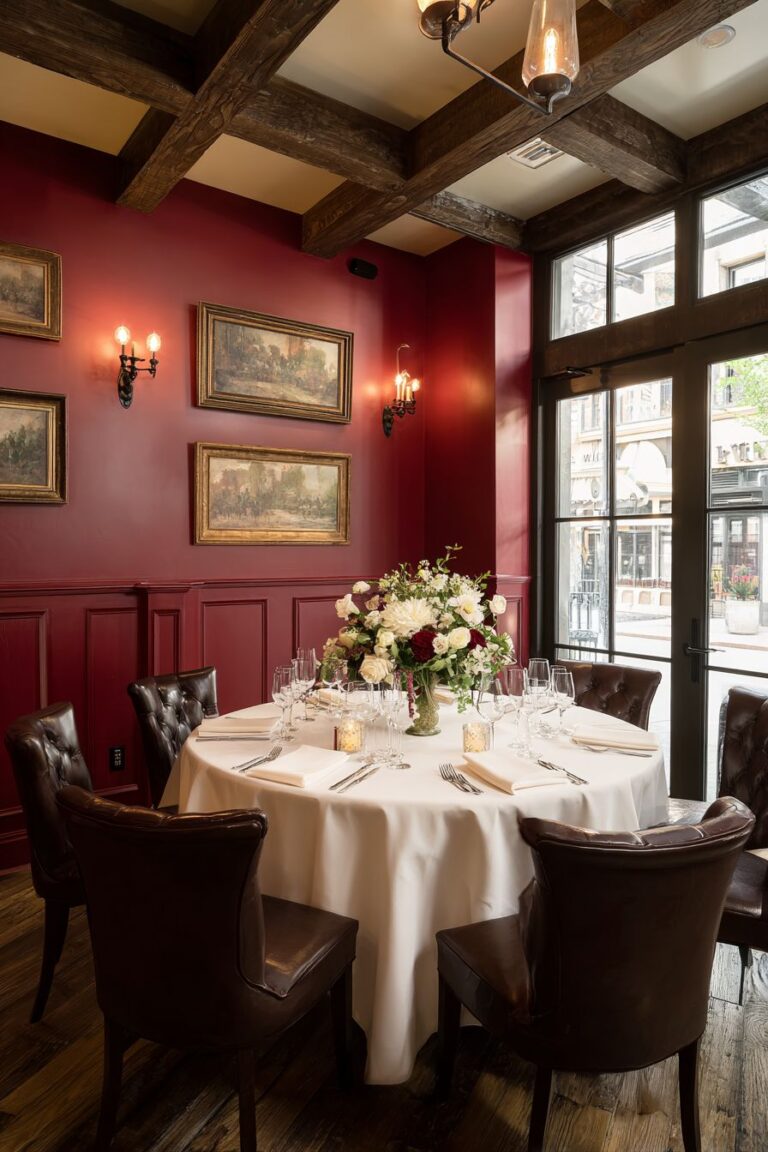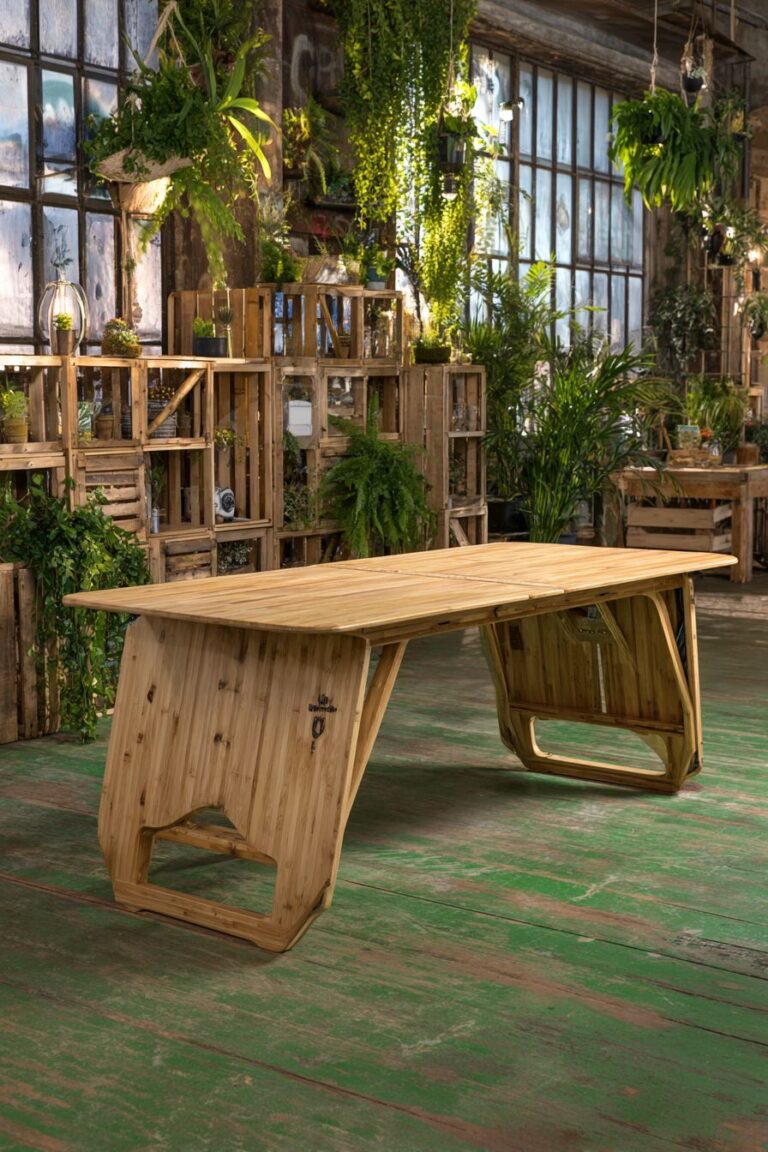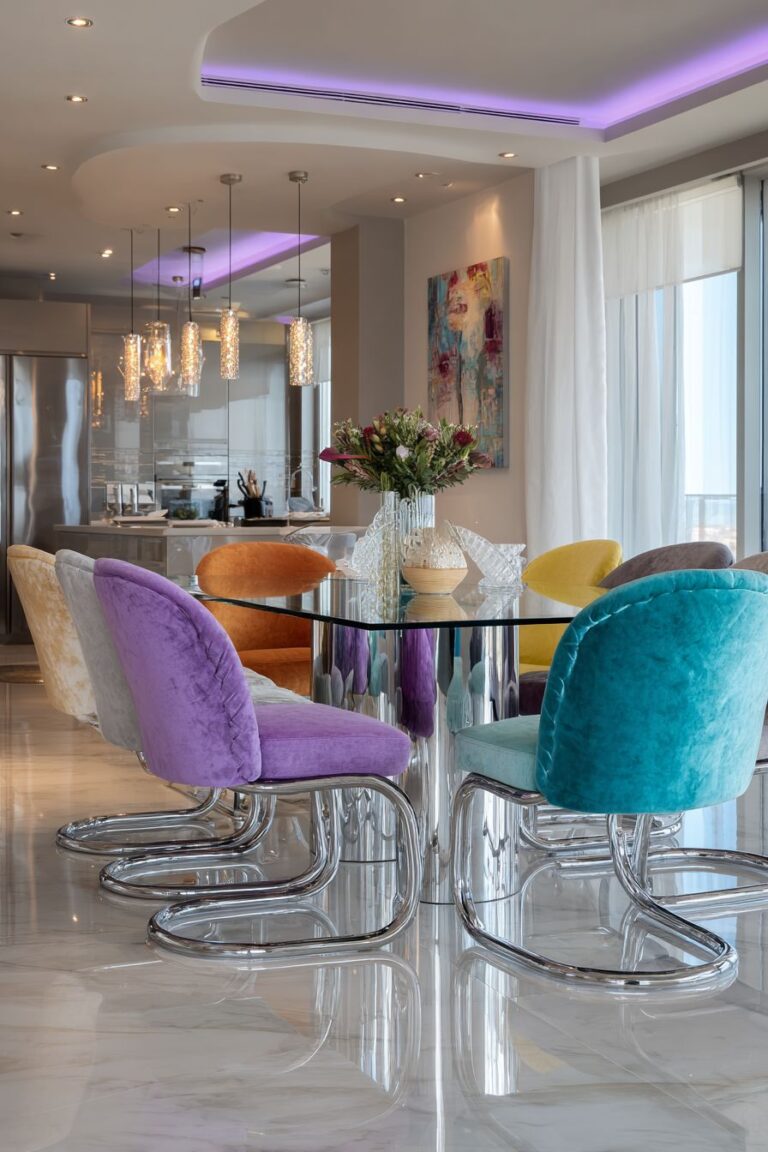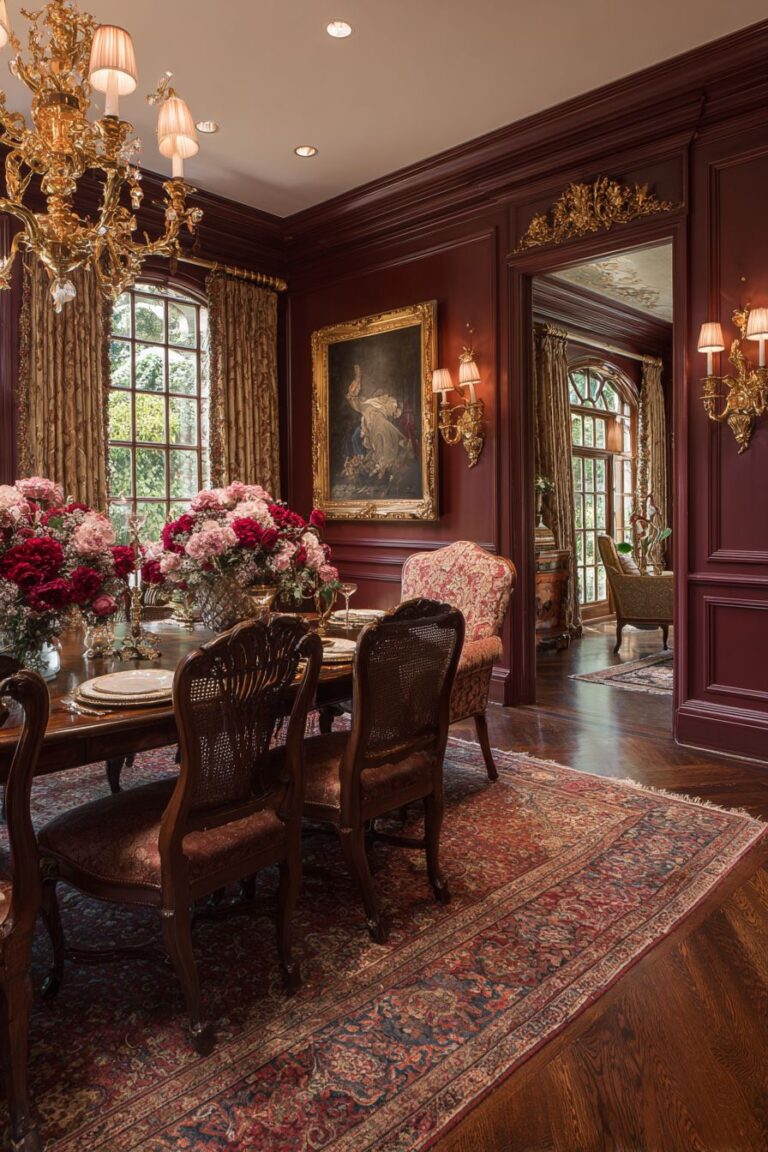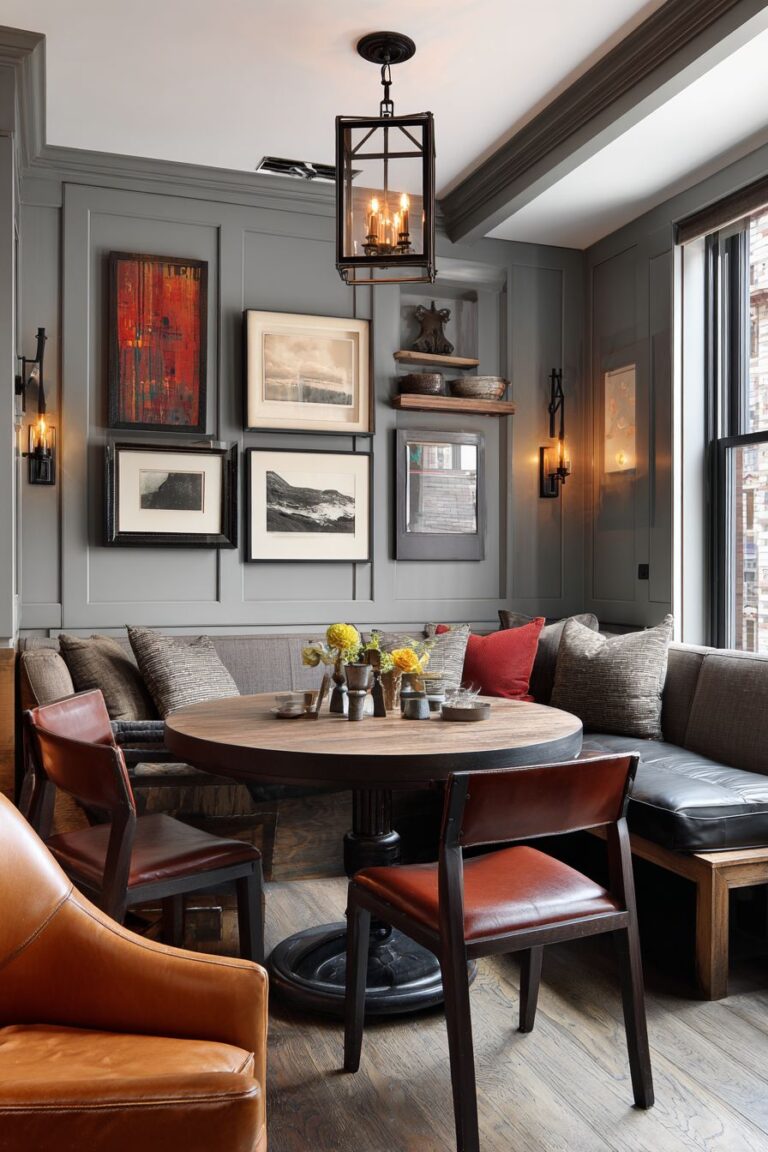20 Inspiring Round Table Dining Room Ideas: Design That Transform Your Space
The dining room serves as the heart of the home, where families gather to share meals, conversations, and create lasting memories. Among all dining furniture configurations, the round table stands as a timeless choice that promotes intimacy, conversation, and effortless flow. Unlike rectangular tables that create natural hierarchies with head positions, round tables democratize the dining experience, ensuring every guest feels equally welcomed and engaged. The circular shape eliminates sharp corners, making navigation safer and more comfortable, particularly in smaller spaces where every square foot matters.
Round dining tables offer unparalleled versatility in both traditional and contemporary settings. Their organic shape softens angular room architectures while creating a natural focal point that draws people together. Whether you’re designing a cozy breakfast nook, an elegant formal dining room, or a multi-functional space that serves various purposes throughout the day, round tables adapt beautifully to diverse design aesthetics. From rustic farmhouse charm to sleek modern minimalism, these circular centerpieces can be styled to complement any interior design vision.
The following collection showcases twenty distinct round table dining room designs, each offering unique perspectives on how this classic furniture piece can transform your space. These carefully curated concepts demonstrate the remarkable flexibility of round tables across various design styles, from industrial lofts to French country estates, proving that circular dining surfaces transcend trends while remaining eternally functional and beautiful.
1. Modern Walnut Elegance
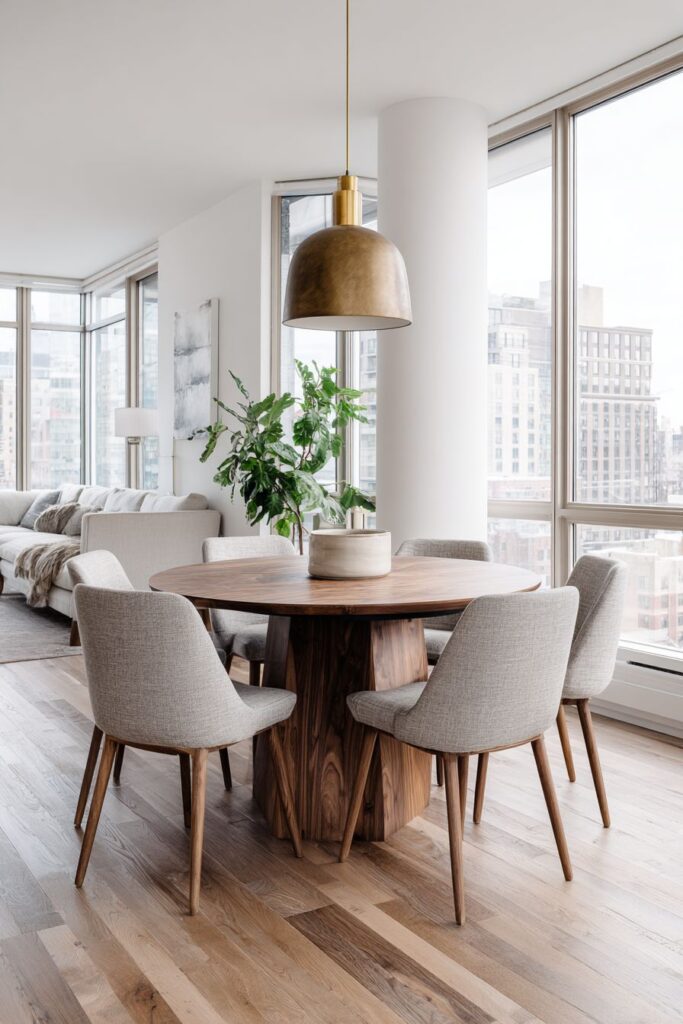
Step into a sophisticated dining space where a stunning 48-inch solid walnut pedestal table commands attention with its rich, chocolate-brown grain patterns that seem to flow like rivers across the surface. The substantial pedestal base provides both visual weight and practical leg room, while six upholstered dining chairs in warm grey linen create a perfect contrast against the dark wood. The chairs’ soft texture invites extended conversations, their neutral tone allowing the walnut’s natural beauty to take center stage without competition.
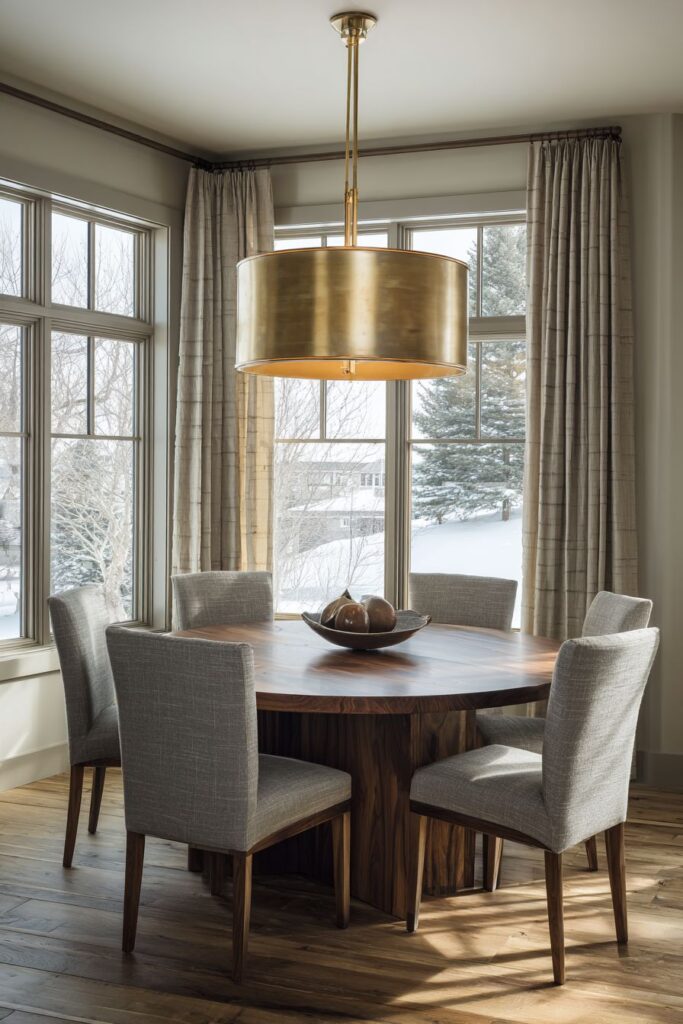
Natural oak flooring beneath adds another layer of wood warmth, its subtle grain variation creating a foundation that grounds the entire composition. Above, a large pendant light fixture with brass accents serves as both illumination and sculpture, its metallic finish catching and reflecting the wood tones below. The interplay between the brass hardware and walnut creates a luxurious palette that feels both contemporary and timeless.
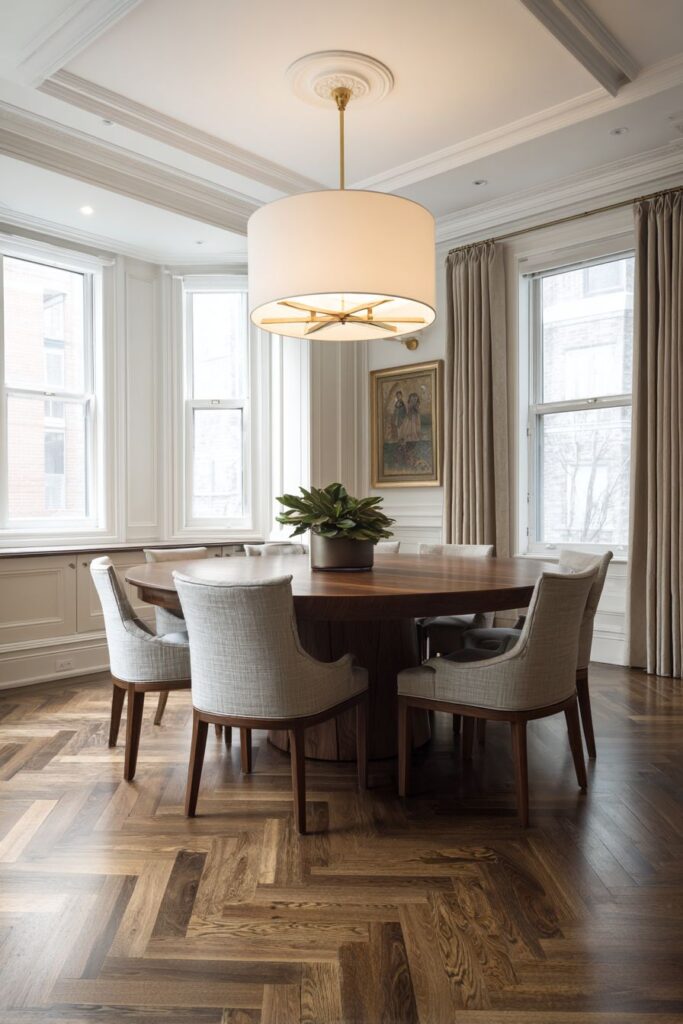
Soft natural lighting streaming through nearby windows bathes the wood surfaces in gentle shadows that shift throughout the day, highlighting different aspects of the grain patterns and creating an ever-changing visual experience. The circular arrangement naturally encourages conversation flow, while the quality materials ensure this space will age beautifully, developing character and patina over time.
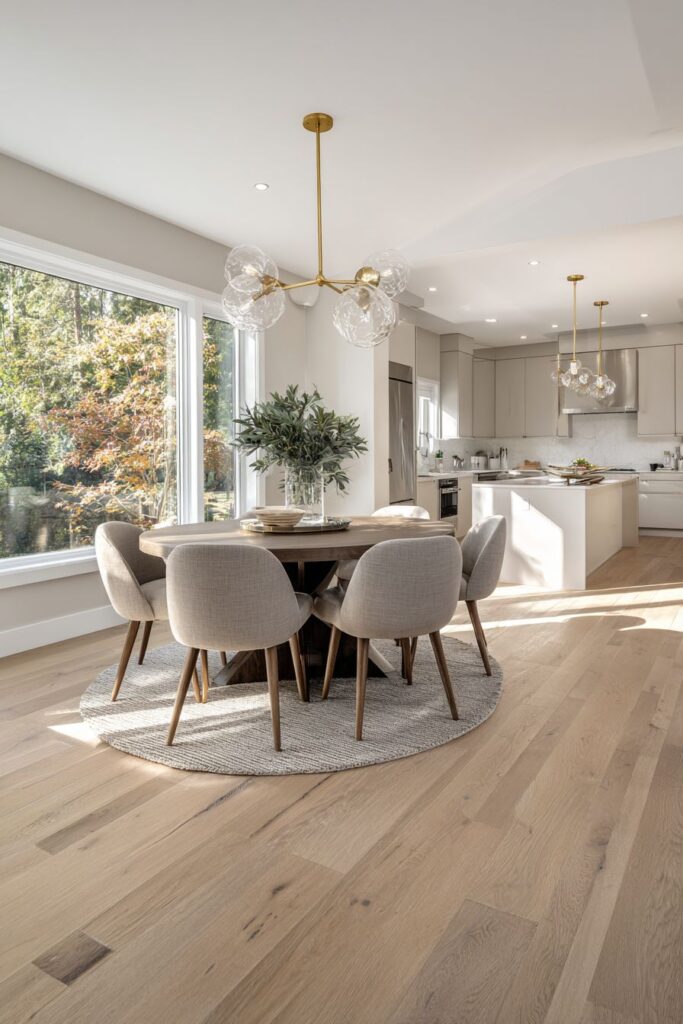
Key Design Tips:
- Invest in solid wood construction for durability and natural beauty that improves with age
- Choose neutral upholstery colors that won’t compete with rich wood tones
- Incorporate brass accents to add warmth and sophistication to the color palette
- Position near natural light sources to showcase wood grain variations throughout the day
- Select pedestal bases for maximum seating flexibility and clean visual lines
2. Farmhouse Reclaimed Pine Charm

Authenticity radiates from every weathered board of this reclaimed pine round table, where decades of use have created a patina that cannot be replicated in new furniture. The natural weathering tells stories through visible knots, grain patterns, and subtle color variations that range from honey blonde to deeper amber tones. This centerpiece pairs beautifully with four mismatched vintage chairs, each representing different eras and woodworking techniques, creating the authentic collected-over-time appearance that defines true farmhouse style.

The beauty of this approach lies in the imperfection – each chair contributes its own character while maintaining complementary wood tones that harmonize rather than match exactly. A simple linen table runner adds understated elegance without overwhelming the rustic foundation, while ceramic bowls in creamy whites and soft blues provide functional beauty that enhances rather than competes with the wood’s natural appeal.

White shiplap walls create a crisp backdrop that allows the warm wood tones to pop forward, while a vintage chandelier fitted with Edison bulbs casts warm, amber light that enhances the cozy atmosphere. The exposed bulbs reference the industrial roots of farmhouse style while providing the perfect amount of illumination for intimate dining experiences.

Key Design Tips:
- Embrace imperfections in reclaimed wood as they add authentic character and history
- Mix and match vintage chairs for an organic, collected-over-time aesthetic
- Use simple linens to add softness without overwhelming rustic elements
- Install Edison bulb fixtures for warm, ambient lighting that enhances wood tones
- Keep accessories minimal and functional to maintain the authentic farmhouse feel
3. Scandinavian Light Oak Serenity
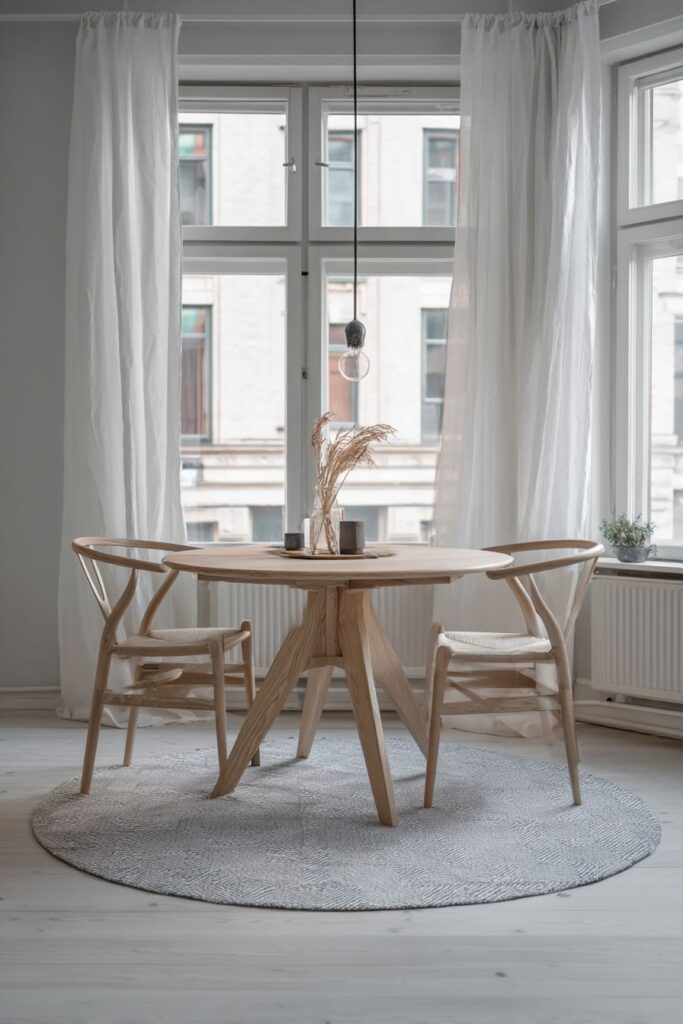
Embodying the essence of Nordic design philosophy, this light oak round table exemplifies the Scandinavian principle that beauty emerges from simplicity. The clean pedestal base eliminates visual clutter while showcasing the pale wood’s subtle grain patterns that seem to glow with inner light. Paired with iconic wishbone chairs in matching natural wood finish, the composition creates a harmonious dialogue between functional art and everyday utility.
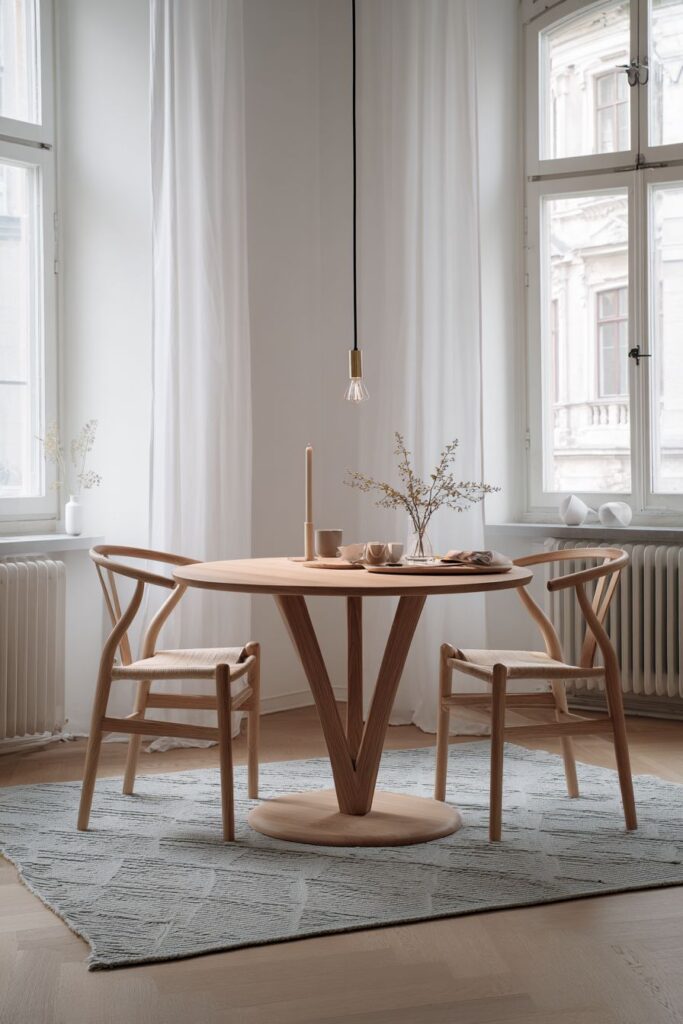
The minimalist space surrounding this tableau features pristine white walls that serve as a calm backdrop, allowing the wood’s natural warmth to provide all necessary visual interest. A geometric wool rug in soft grey tones anchors the seating area while adding texture without introducing competing patterns. The rug’s neutral palette maintains the serene atmosphere while providing comfort underfoot.
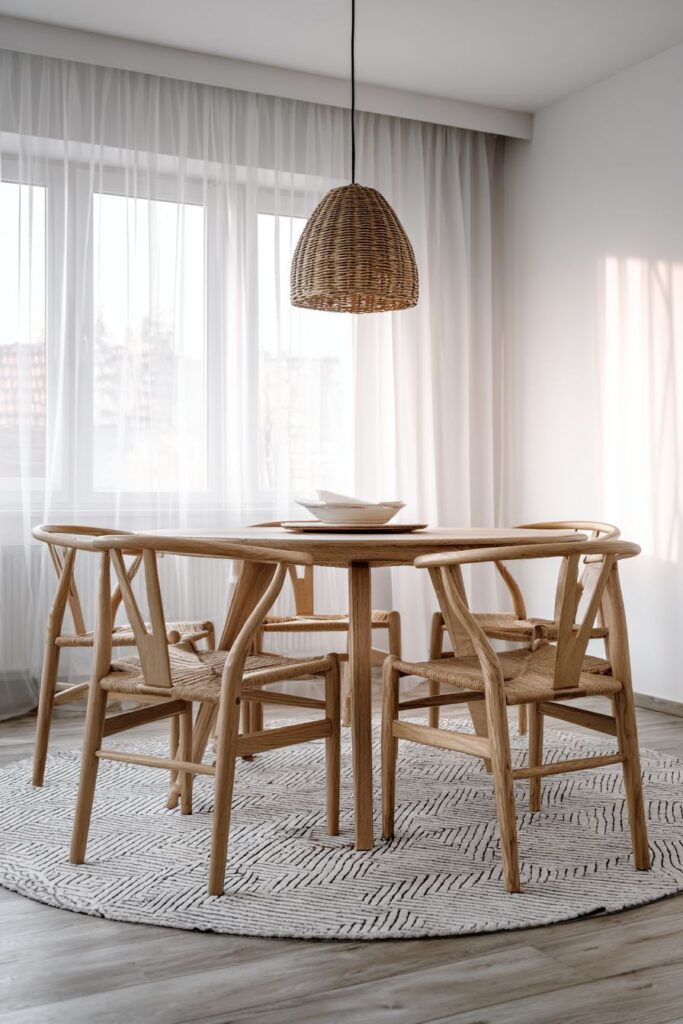
Natural daylight filtering through sheer white curtains creates an ethereal quality that changes throughout the day, casting gentle shadows that highlight the wood grain’s natural beauty. A simple pendant lamp with black cord provides task lighting when needed while maintaining the aesthetic’s clean lines. This approach proves that restraint in design choices can create spaces of profound beauty and lasting appeal.
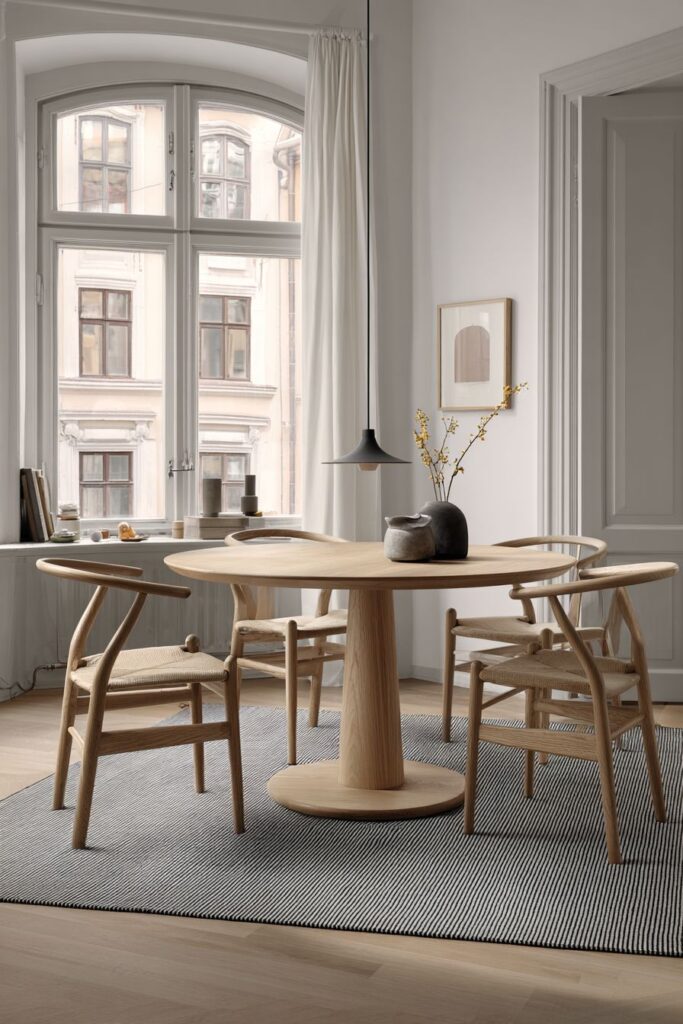
Key Design Tips:
- Choose light wood tones to maximize brightness in natural light
- Embrace white walls as a serene backdrop that never goes out of style
- Select geometric rugs in neutral tones to add texture without visual noise
- Use sheer window treatments to maximize natural light while maintaining privacy
- Keep accessories minimal to let natural materials be the star
4. Small Apartment Marble Sophistication
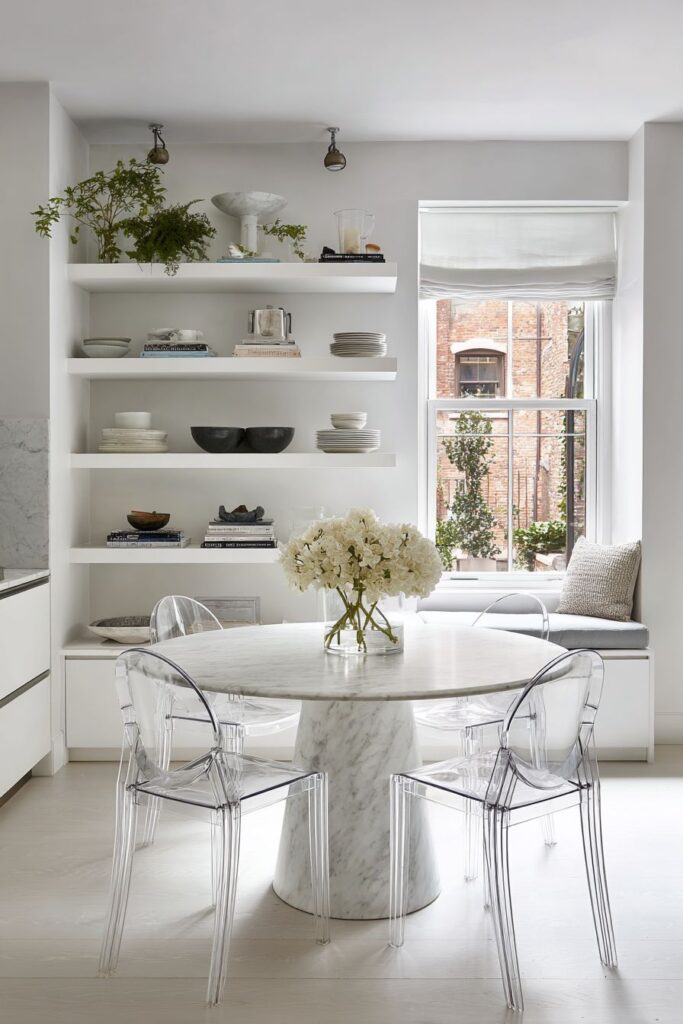
In compact living spaces, every design decision must serve multiple purposes, and this 36-inch marble-top round table demonstrates how luxury and functionality can coexist beautifully. The sleek metal base virtually disappears visually while providing rock-solid support for the dramatic white marble top with its distinctive grey veining. Four acrylic chairs maintain visual openness by allowing light to pass through, preventing the small space from feeling cramped or cluttered.
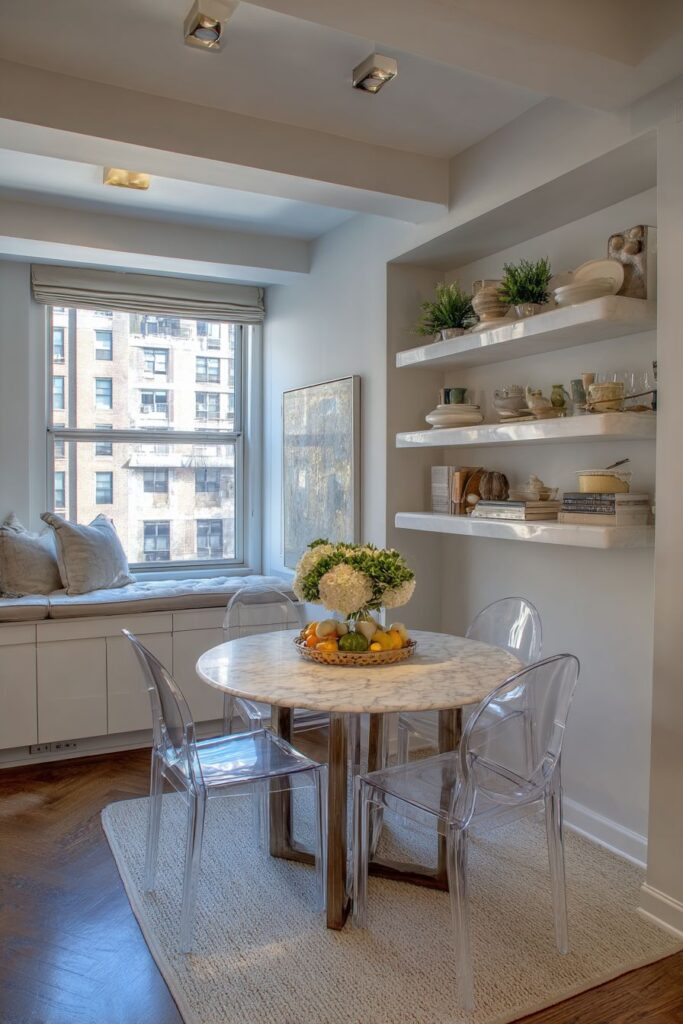
Built-in floating shelves along one wall maximize vertical storage while displaying curated dishware and plants that add life and personality to the compact area. The shelving’s clean lines complement the table’s modern aesthetic while providing essential storage without encroaching on precious floor space. Each displayed item serves both functional and decorative purposes, embodying the smart design principles essential in small-space living.
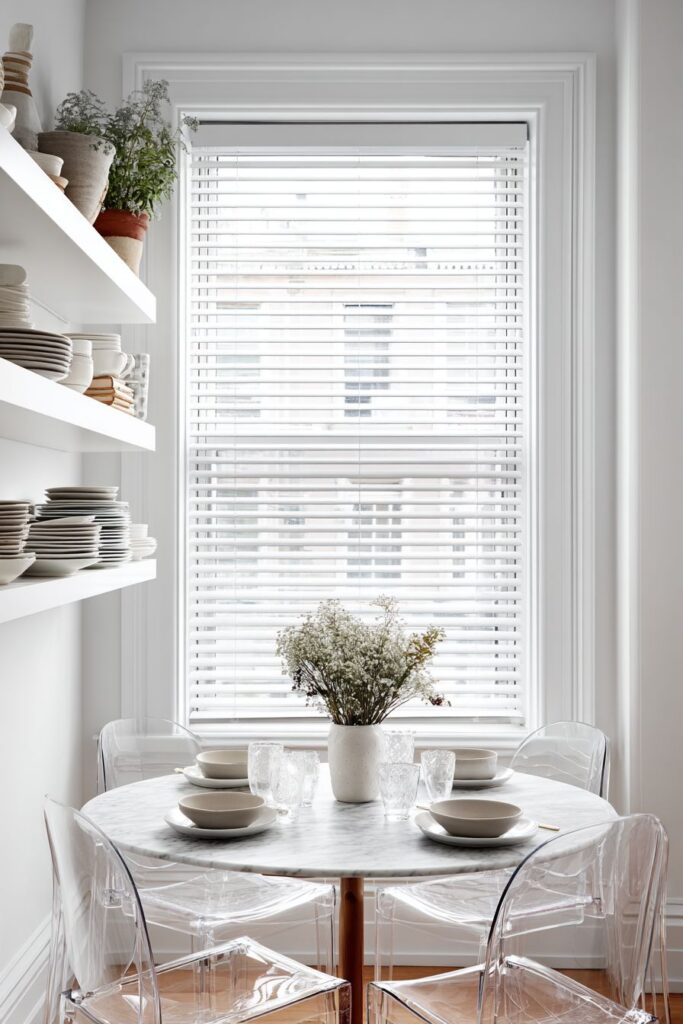
Natural light from a single window becomes precious in this compact setting, enhanced by minimalist white blinds that can be adjusted throughout the day to control illumination and privacy. The round table’s configuration optimizes traffic flow around the space while accommodating four diners comfortably, proving that size limitations need not compromise style or functionality.
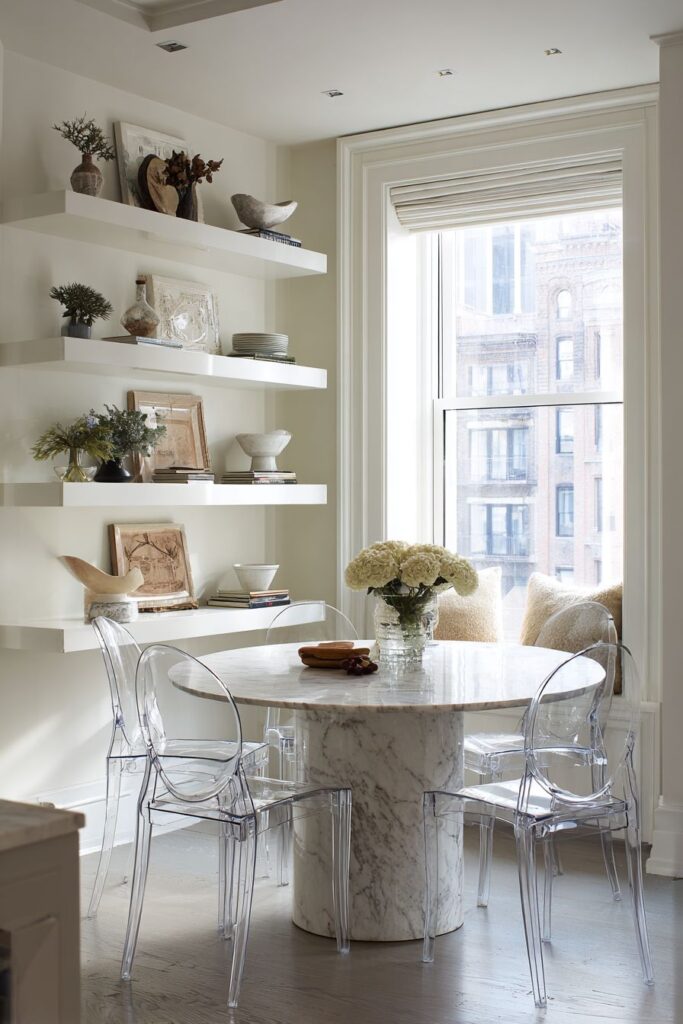
Key Design Tips:
- Choose transparent furniture elements to maintain visual flow in tight spaces
- Utilize vertical storage solutions to maximize functionality without cluttering floors
- Select marble surfaces to add luxury even in small footprints
- Optimize round table sizing for space efficiency while maintaining comfort
- Maximize natural light with minimal window treatments and light-reflecting surfaces
5. Industrial Concrete and Steel Character
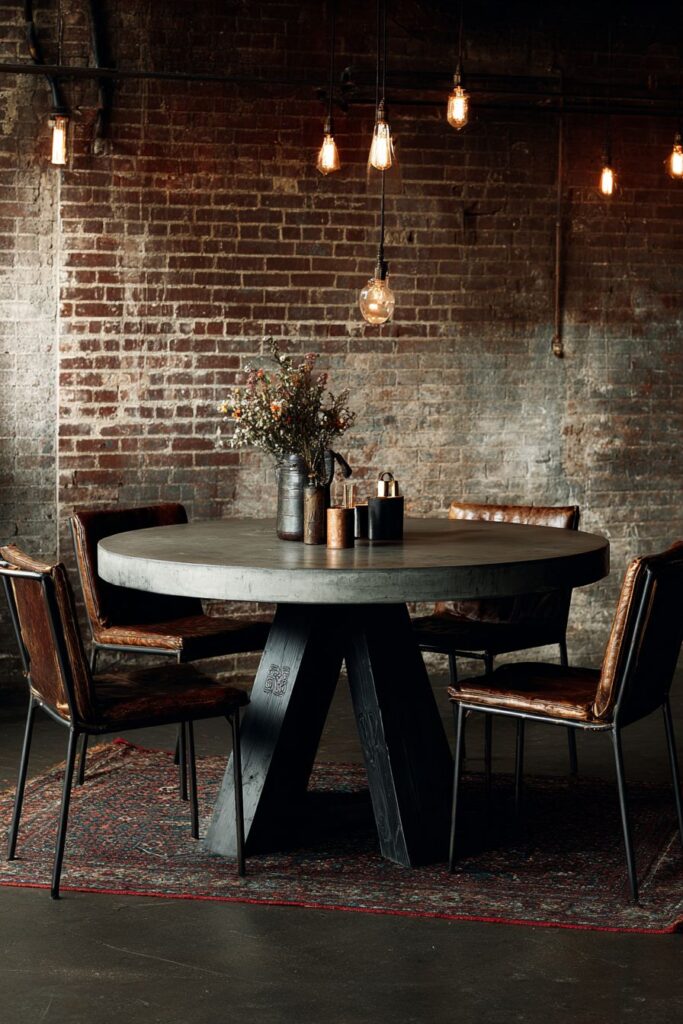
Raw materials take center stage in this industrial-inspired dining space, where a concrete-top round table with blackened steel hairpin legs creates an urban aesthetic that celebrates unfinished beauty. The concrete surface develops character over time, gaining subtle stains and patina that tell the story of countless shared meals. Its substantial weight and cool touch provide a striking contrast to the delicate appearance of the slender hairpin legs, creating visual tension that defines industrial design.
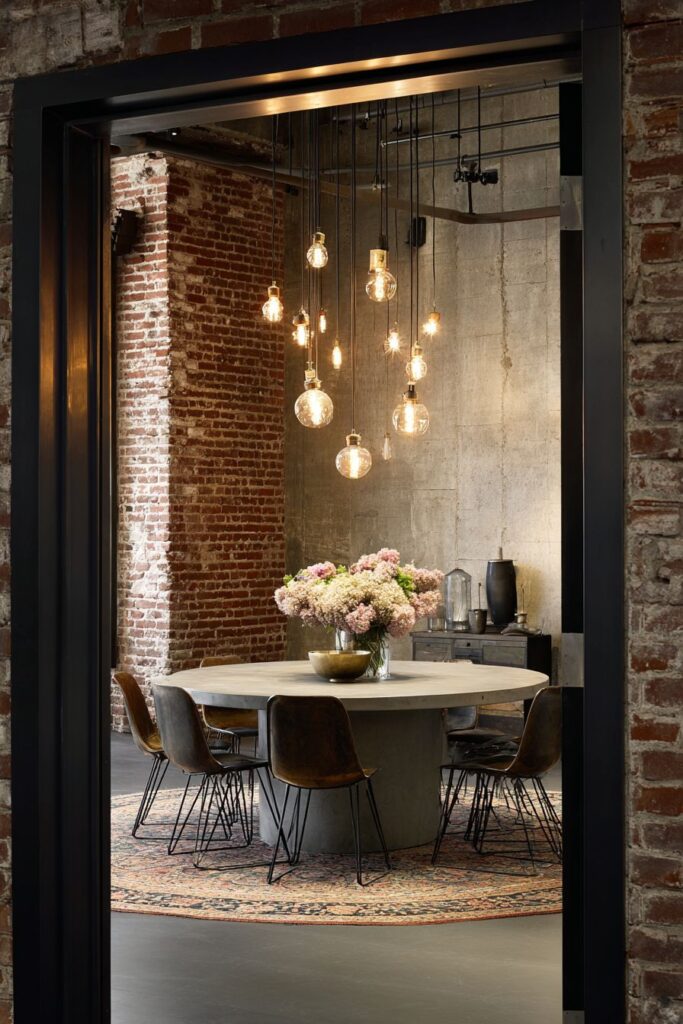
Metal dining chairs with worn leather seats complement the table’s industrial heritage while providing comfortable seating that improves with age. The leather develops a rich patina through use, creating the authentic worn appearance that cannot be manufactured. This marriage of metal and leather references the industrial workplaces that inspired this design aesthetic, where function always preceded form but beauty emerged naturally from honest materials.
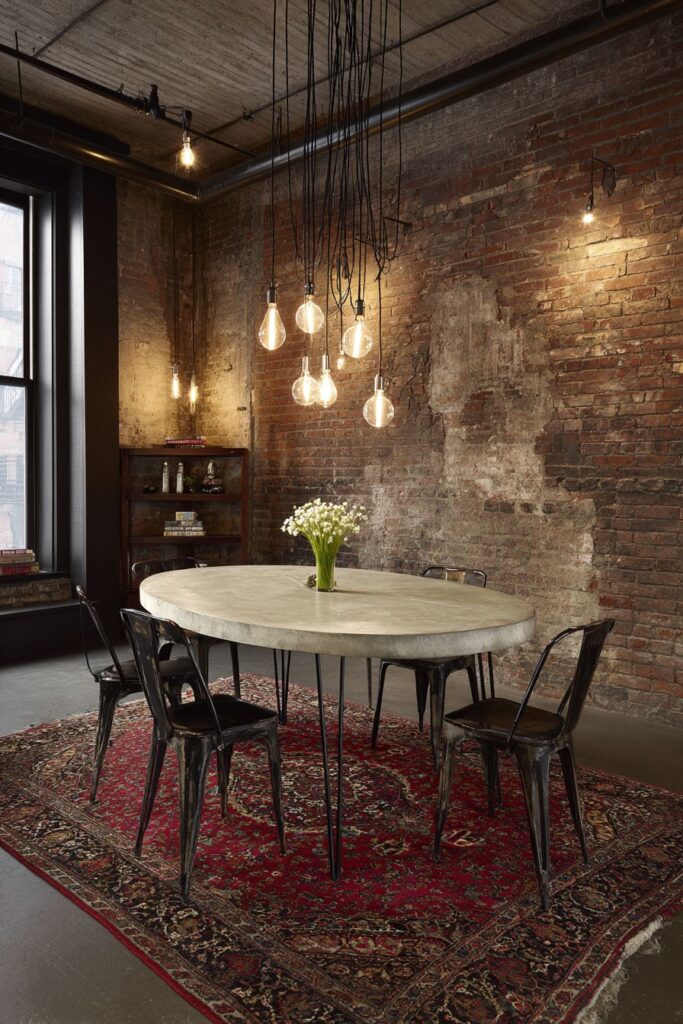
Exposed brick walls provide textural interest and warmth that balances the cool concrete and steel elements, while Edison bulb track lighting emphasizes the urban atmosphere through both form and function. A vintage Persian rug in muted colors anchors the space and adds unexpected softness, proving that industrial design can incorporate traditional elements when they share similar aged character and authentic patina.
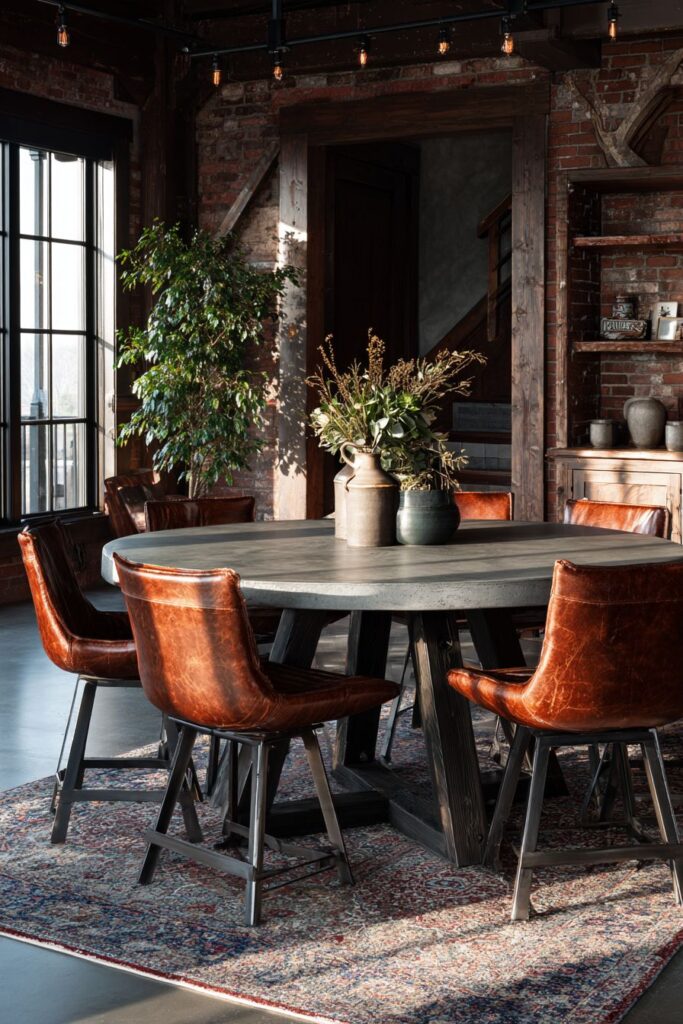
Key Design Tips:
- Embrace raw materials like concrete and steel for authentic industrial appeal
- Choose furnishings that improve with age such as leather and worn metals
- Incorporate exposed architectural elements like brick walls for texture and warmth
- Use Edison bulb lighting to reference industrial origins while providing ambiance
- Add vintage textiles to soften hard surfaces and introduce unexpected color
6. Traditional Mahogany Grandeur
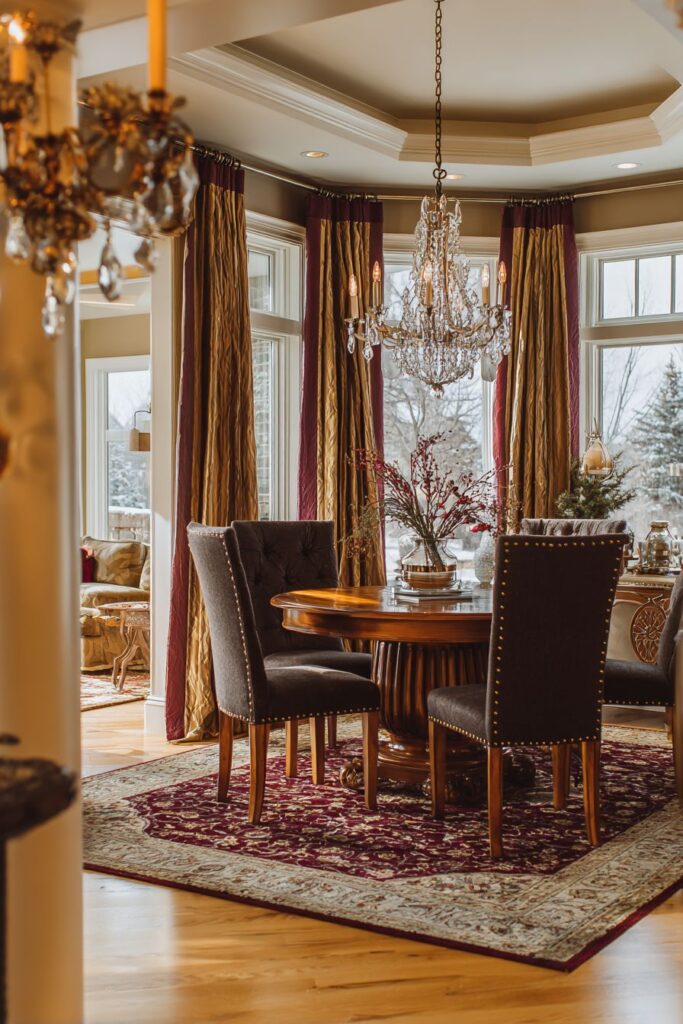
Timeless elegance reaches its peak in this formal dining space, where a rich mahogany pedestal table serves as the cornerstone of traditional sophistication. The deep reddish-brown wood showcases decades of craftsmanship traditions, its lustrous finish reflecting light in ways that highlight the natural grain’s complex patterns. Surrounded by upholstered dining chairs in deep navy fabric with brass nailhead trim, the composition creates a palette of deep, saturated colors that exude confidence and permanence.
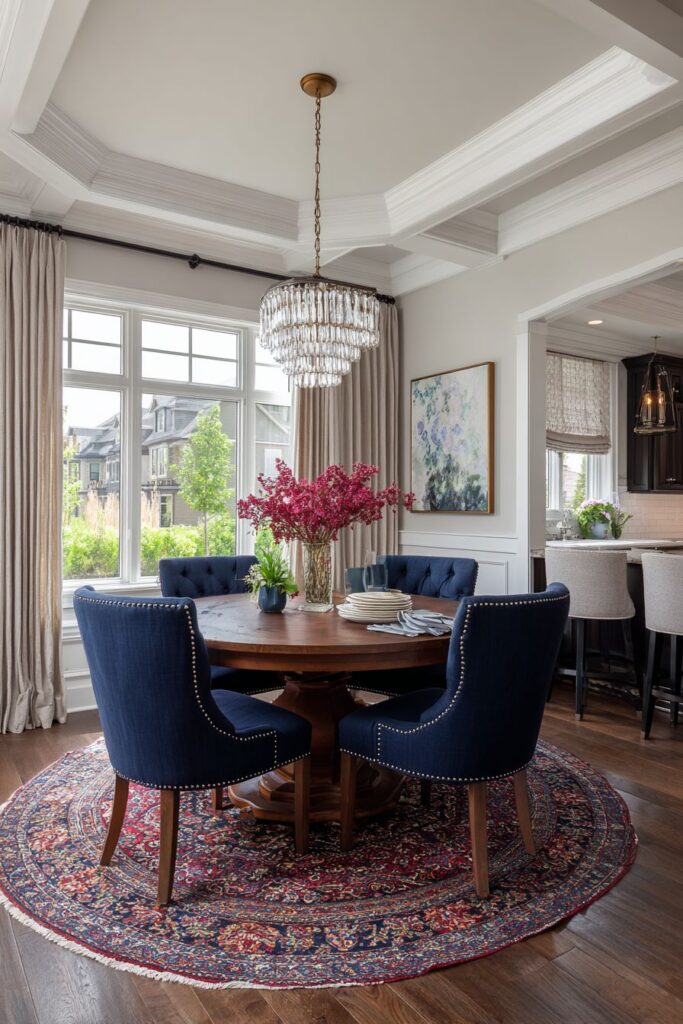
Architectural details elevate this space beyond mere furniture arrangement into the realm of interior architecture. Wainscoting provides visual weight and traditional charm at the room’s base, while crown molding adds sophisticated finishing touches that frame the ceiling beautifully. These classic millwork elements create a backdrop worthy of the fine furnishings they surround, demonstrating how architectural details and furniture must work in harmony to create truly elegant spaces.
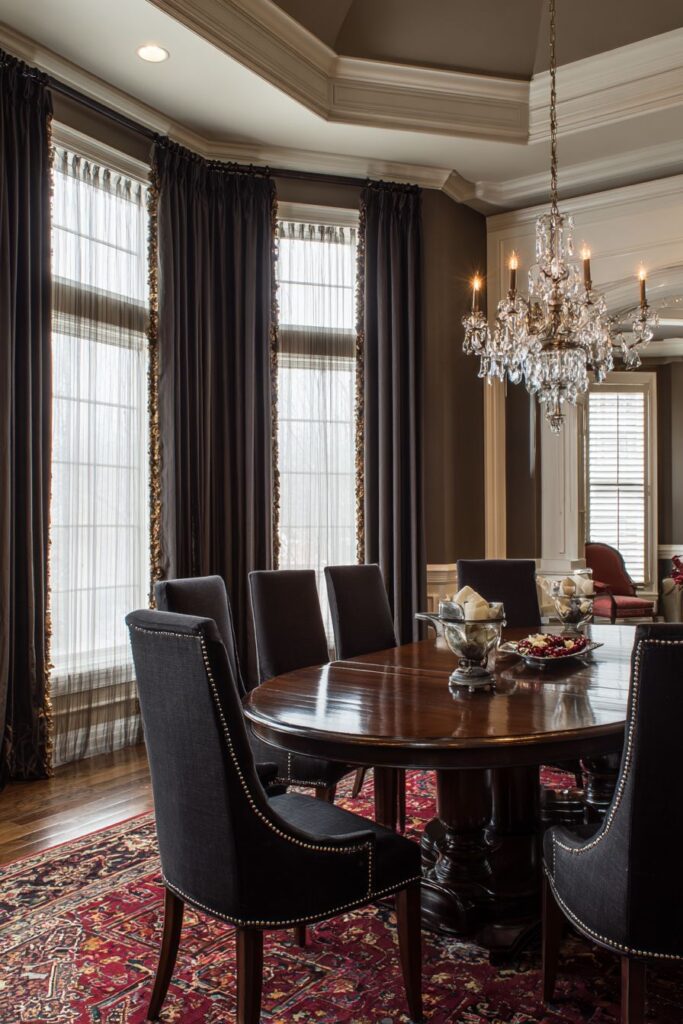
A crystal chandelier suspended above the table provides both illumination and glamour, its faceted elements casting dancing light patterns across the mahogany’s polished surface. The Persian rug in burgundy and gold tones complements the rich color palette while adding pattern and texture underfoot. Heavy drapes frame tall windows, controlling natural light while adding layers of luxury that define traditional formal dining.
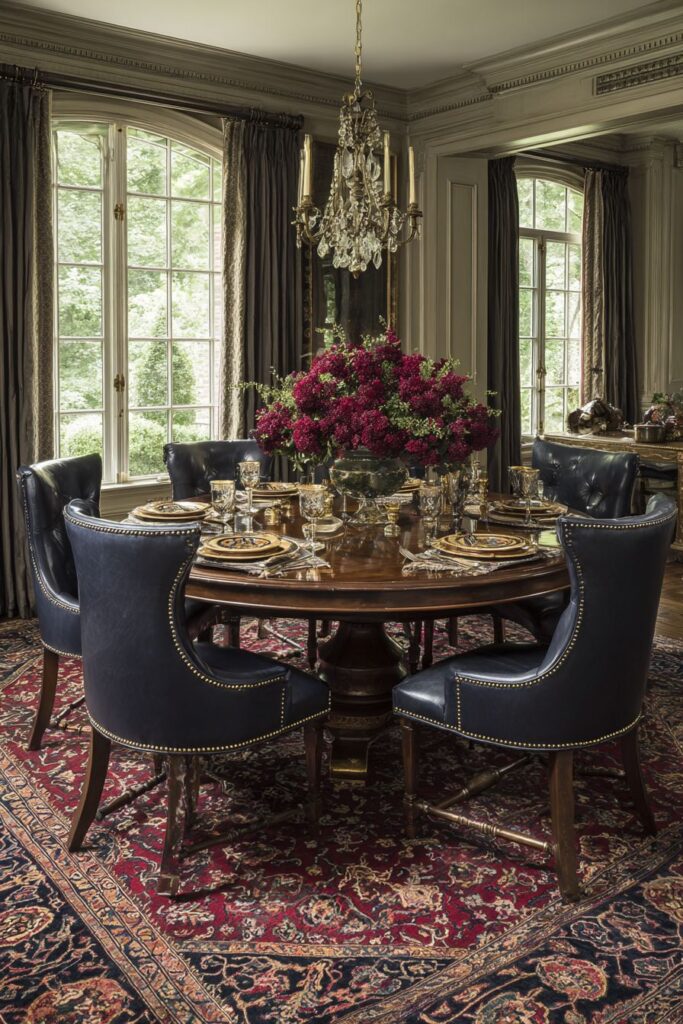
Key Design Tips:
- Invest in quality hardwood furniture with rich finishes that develop character over time
- Use deep, saturated colors to create sophisticated, formal atmospheres
- Add architectural millwork like wainscoting and crown molding for authentic period detail
- Choose crystal lighting fixtures to add sparkle and traditional elegance
- Layer textiles through rugs and window treatments for depth and luxury
7. Coastal Weathered White Oak Breeziness
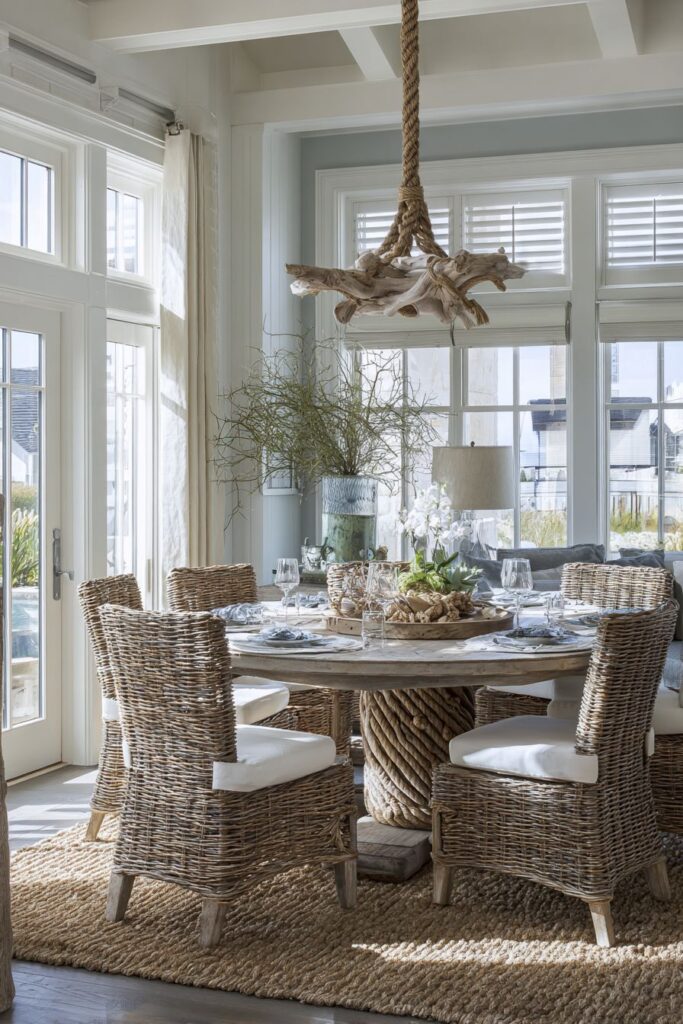
Ocean breezes seem to flow naturally through this coastal-inspired dining space, where a weathered white oak round table with rope-wrapped pedestal base channels seaside serenity. The table’s surface shows the gentle aging that comes from salt air and time, creating subtle color variations that range from pale cream to soft grey. The rope detailing around the base references nautical traditions while adding textural interest that invites touch and examination.
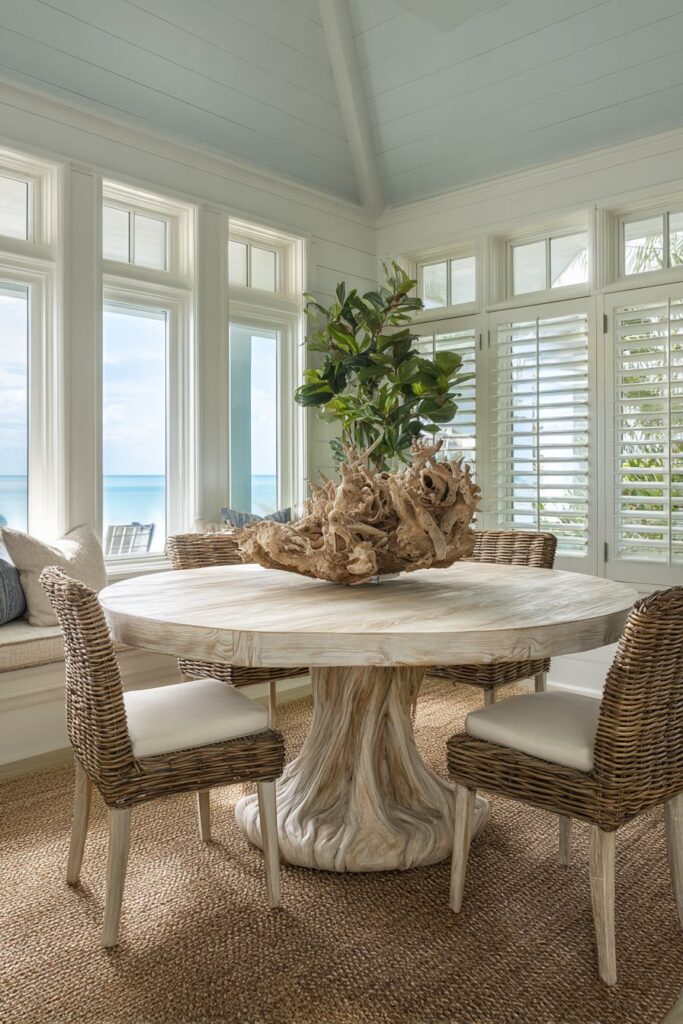
Rattan dining chairs with cream cushions provide comfortable seating that breathes with the coastal climate while maintaining the natural material palette that defines this style. The woven rattan adds organic texture that complements the oak’s weathered surface, creating layers of natural materials that feel authentically beachside. Soft cushions in neutral cream provide comfort while maintaining the light, airy color scheme.
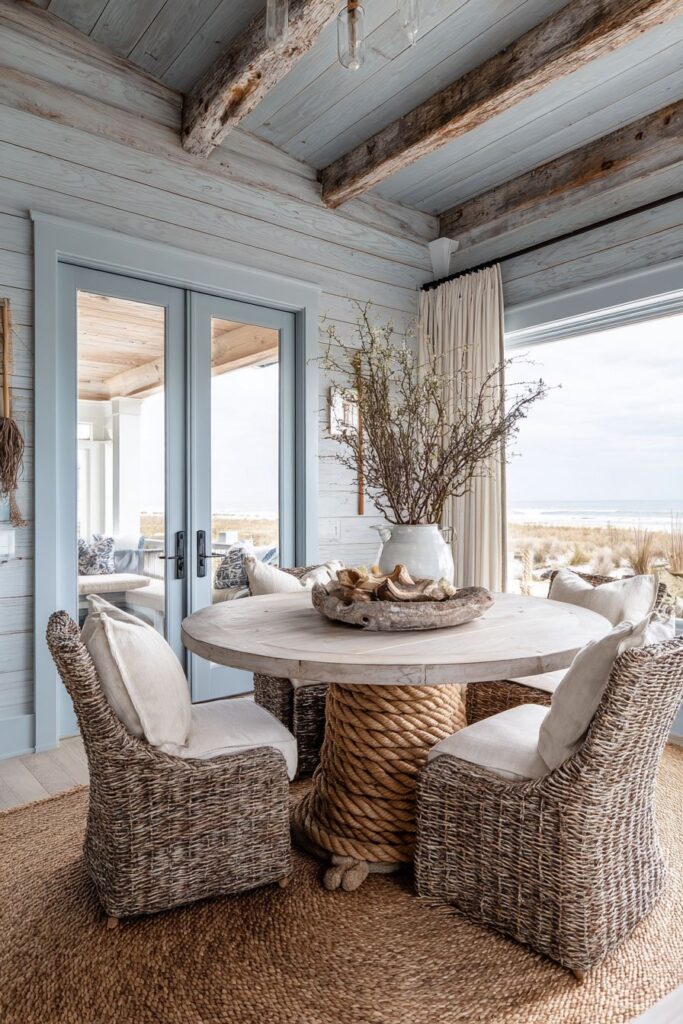
Shiplap walls painted in soft blue-grey create the perfect backdrop for this coastal composition, their horizontal lines referencing traditional boat building techniques while providing visual movement that enhances the room’s relaxed atmosphere. A natural jute rug grounds the seating area with earthy texture, while a driftwood centerpiece brings the outside in. Large windows with plantation shutters flood the space with bright coastal light that changes throughout the day, creating the ever-shifting illumination that defines waterfront living.
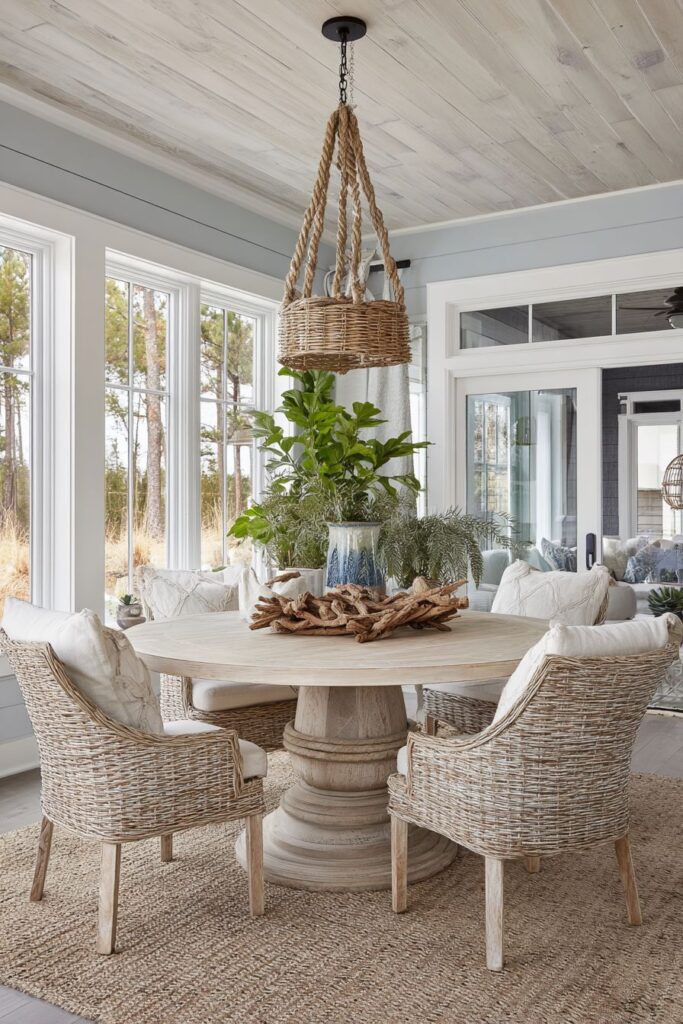
Key Design Tips:
- Choose weathered wood finishes that reference natural aging from salt air
- Incorporate rope and rattan details for authentic nautical character
- Use soft blue-grey paint colors that echo ocean and sky tones
- Maximize natural light with plantation shutters that control but don’t block sunshine
- Add natural elements like driftwood and jute to bring outdoor textures inside
8. Mid-Century Modern Teak Authenticity
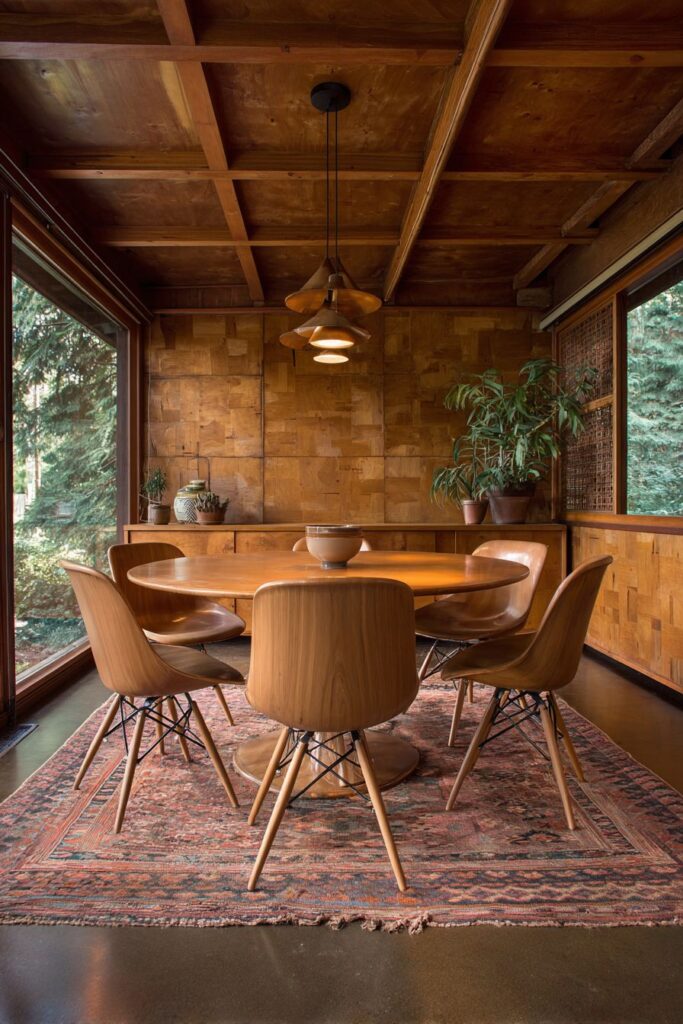
Stepping into this mid-century modern dining space feels like traveling back to the golden age of design, where a teak round table with elegant tapered legs exemplifies the period’s marriage of organic materials with clean, geometric forms. The rich honey-colored teak showcases the distinctive grain patterns that made this wood the material of choice for discerning designers of the 1950s and 60s. Paired with iconic molded plywood chairs in walnut veneer, the composition creates a textbook example of mid-century modern aesthetics.
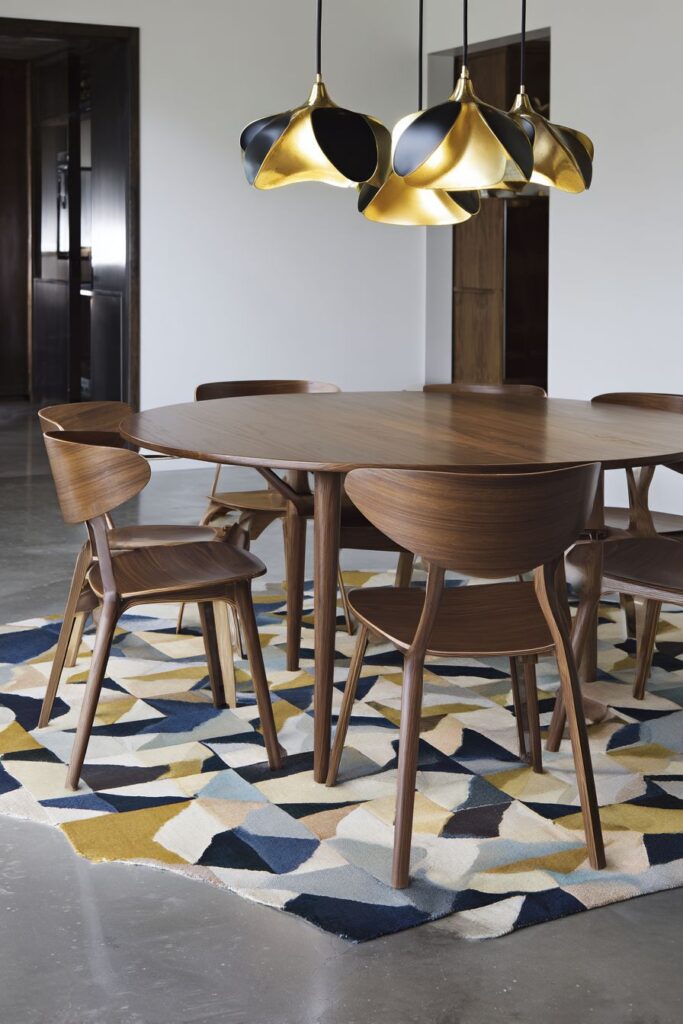
The built-in credenza along one wall demonstrates the period’s love for integrated storage solutions that maintain clean lines while providing essential functionality. Its low profile and horizontal emphasis complement the room’s overall proportions while offering display space for carefully chosen decorative objects that reflect the era’s appreciation for both form and function. The credenza’s walnut finish echoes the dining chairs, creating visual continuity throughout the space.
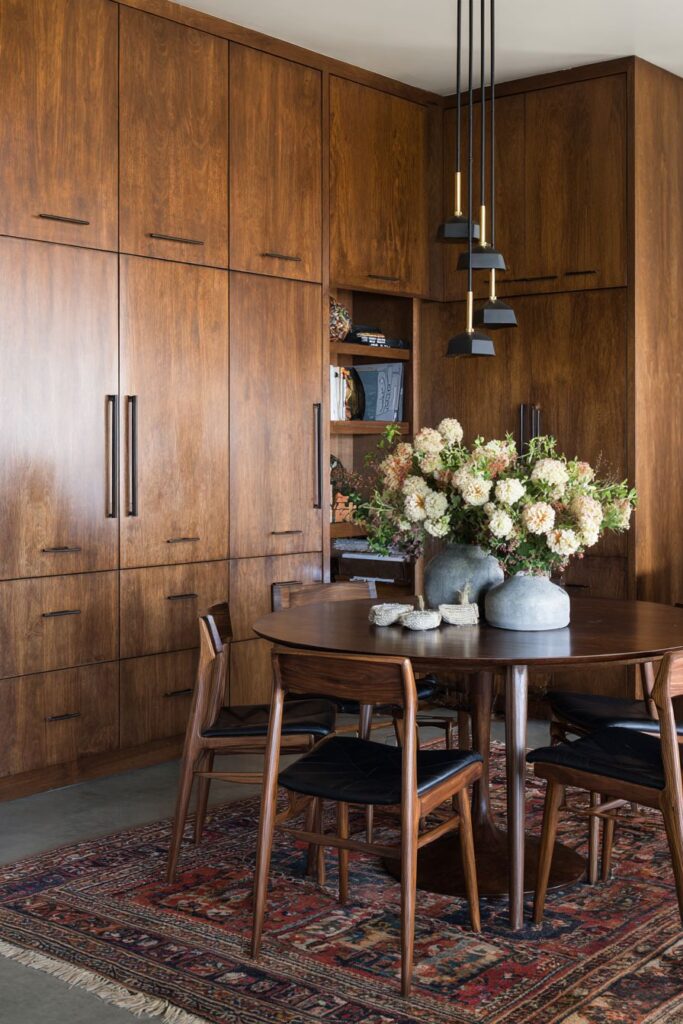
Geometric pendant lighting in brass and black provides task illumination while serving as sculptural art that defines the space above the dining table. The fixture’s clean lines and contrasting materials exemplify mid-century modern design principles that celebrated honest materials and functional beauty. A vintage kilim rug adds pattern and warmth to polished concrete floors, its geometric motifs complementing the overall aesthetic while providing comfort and sound absorption.
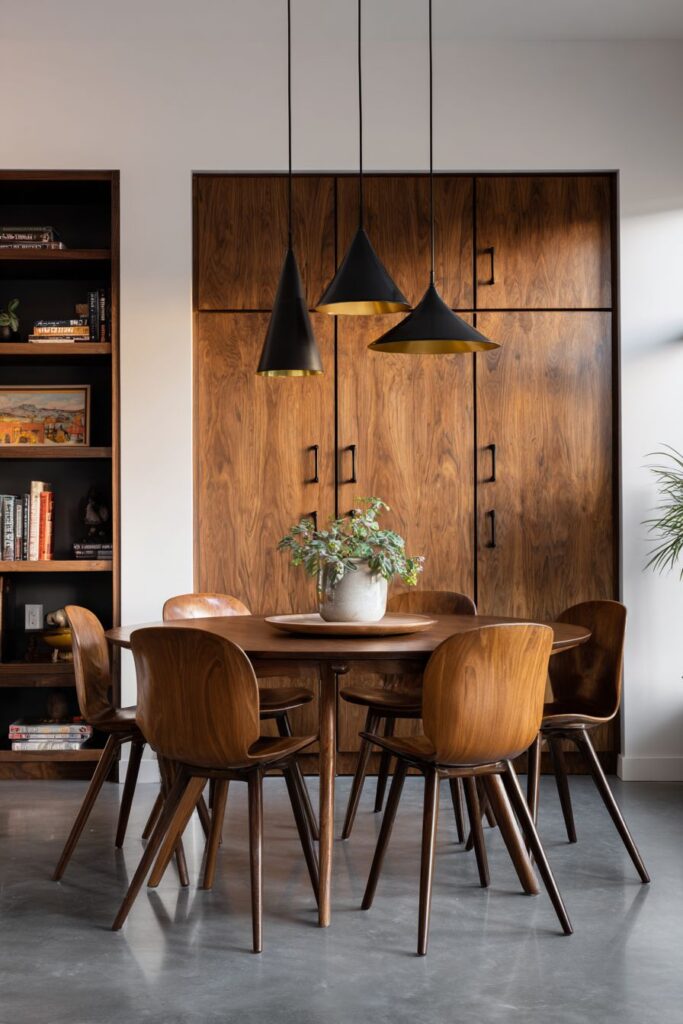
Key Design Tips:
- Choose teak furniture for authentic period material and distinctive grain patterns
- Incorporate geometric lighting fixtures that serve as functional sculpture
- Use built-in storage solutions to maintain clean lines and integrated aesthetics
- Select vintage textiles with geometric patterns that complement the era’s design motifs
- Balance warm woods with cool materials like concrete for authentic contrast
9. Contemporary Glass and Chrome Glamour

Modern sophistication reaches new heights in this contemporary dining space, where a glass-top round table on a sculptural white base creates an almost floating effect that maximizes light and space. The transparent surface allows the base’s artistic form to shine through while reflecting light from multiple sources, creating an ever-changing display of illumination and shadow. Sleek dining chairs upholstered in charcoal grey leather provide comfortable seating while adding rich texture that grounds the ethereal table design.
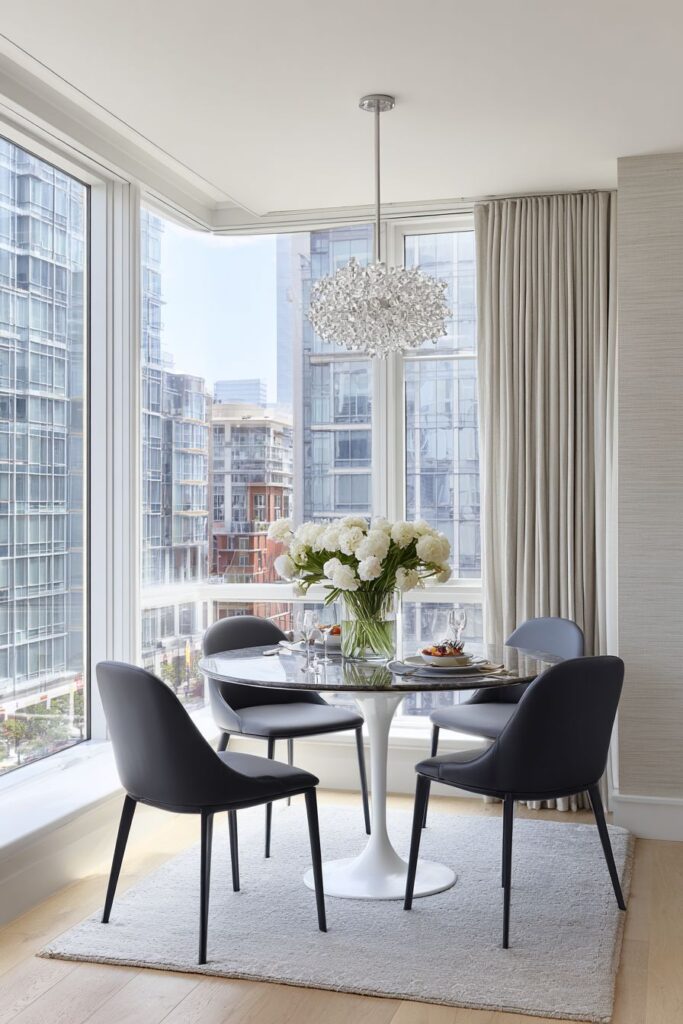
Floor-to-ceiling windows transform this dining area into a light-filled sanctuary where the boundary between interior and exterior becomes beautifully blurred. The dramatic natural lighting changes throughout the day, creating different moods and highlighting various aspects of the room’s sophisticated material palette. During evening hours, a statement chandelier with crystal elements adds glamour while providing necessary task lighting for dining activities.
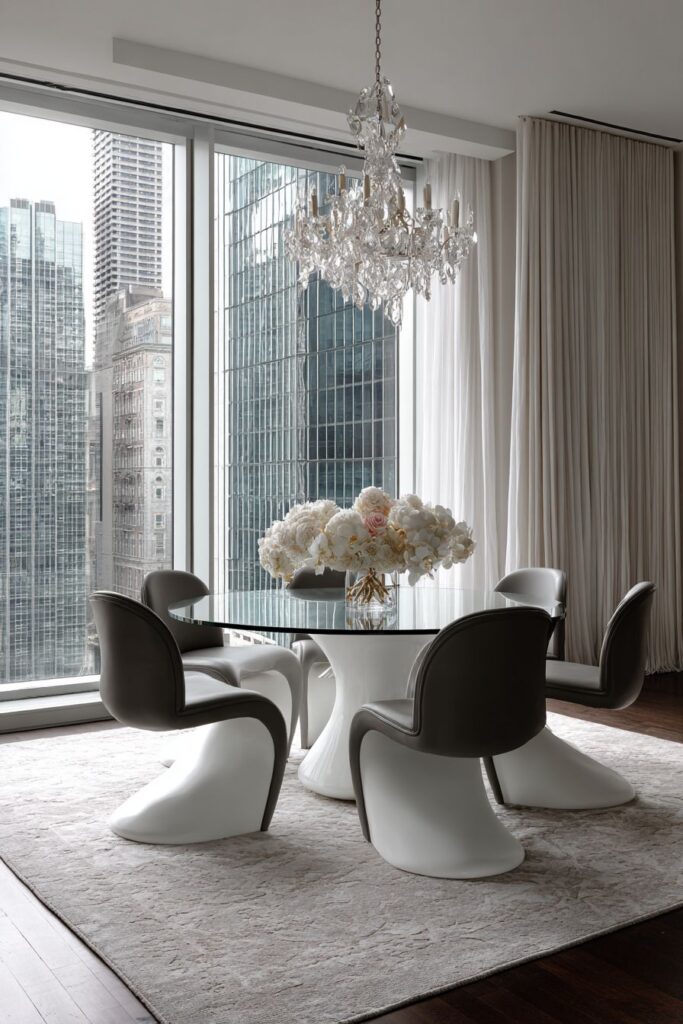
The neutral color palette creates a serene backdrop that allows the play of light and reflection to provide visual interest. Textured wall treatments add subtle pattern without overwhelming the space’s clean aesthetic, while a plush area rug defines the dining area and adds comfort underfoot. This approach demonstrates how contemporary design can achieve luxury through restraint and careful attention to light, proportion, and material quality.

Key Design Tips:
- Use glass surfaces to maximize light reflection and create floating effects
- Choose sculptural furniture bases that serve as functional art pieces
- Incorporate floor-to-ceiling windows to blur interior-exterior boundaries
- Select crystal lighting elements to add sparkle and sophisticated glamour
- Maintain neutral palettes to let light and reflection provide visual interest
10. Bohemian Carved Mango Wood Eclecticism

Global influences converge beautifully in this bohemian dining space, where a carved mango wood round table displays intricate details that celebrate traditional craftsmanship from around the world. The rich golden-brown wood features hand-carved patterns that tell stories of ancient techniques passed down through generations, each curve and flourish representing hours of skilled artisan work. Mixed vintage chairs with colorful upholstery create an eclectic seating arrangement that embraces the bohemian philosophy of collecting beautiful objects from various cultures and eras.
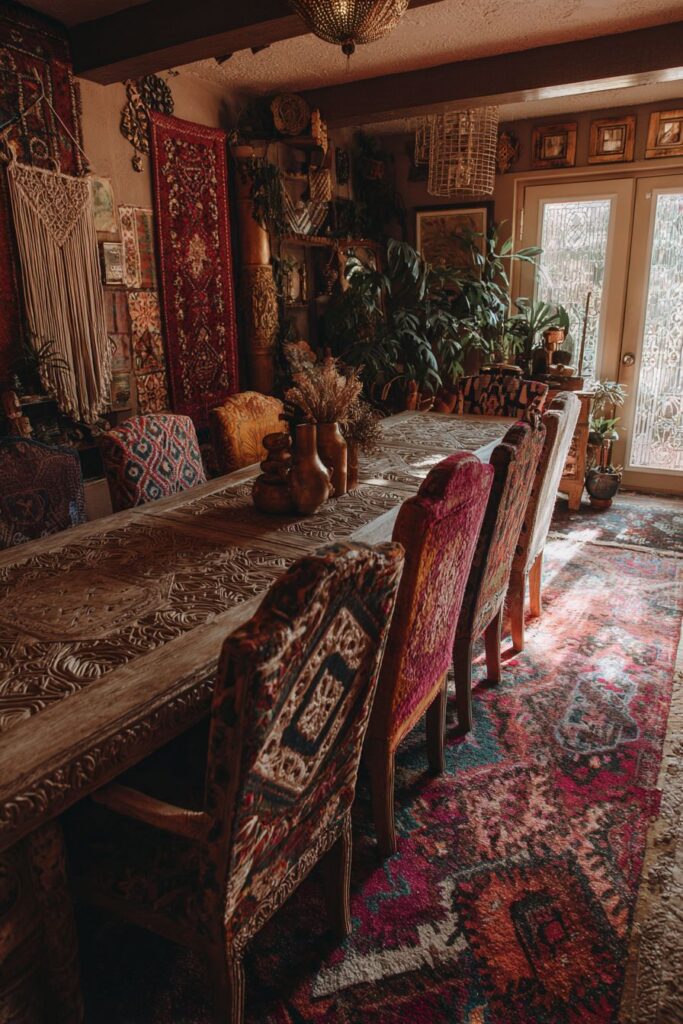
Layered textiles throughout the space demonstrate the bohemian approach to creating visual richness through pattern, color, and texture. A vibrant Persian rug anchors the dining area with deep reds, blues, and gold tones that complement the mango wood’s warm hue, while a macrame wall hanging adds vertical interest and references the 1970s revival of traditional fiber arts. These textile elements create layers of comfort and visual interest that invite extended gatherings and conversation.
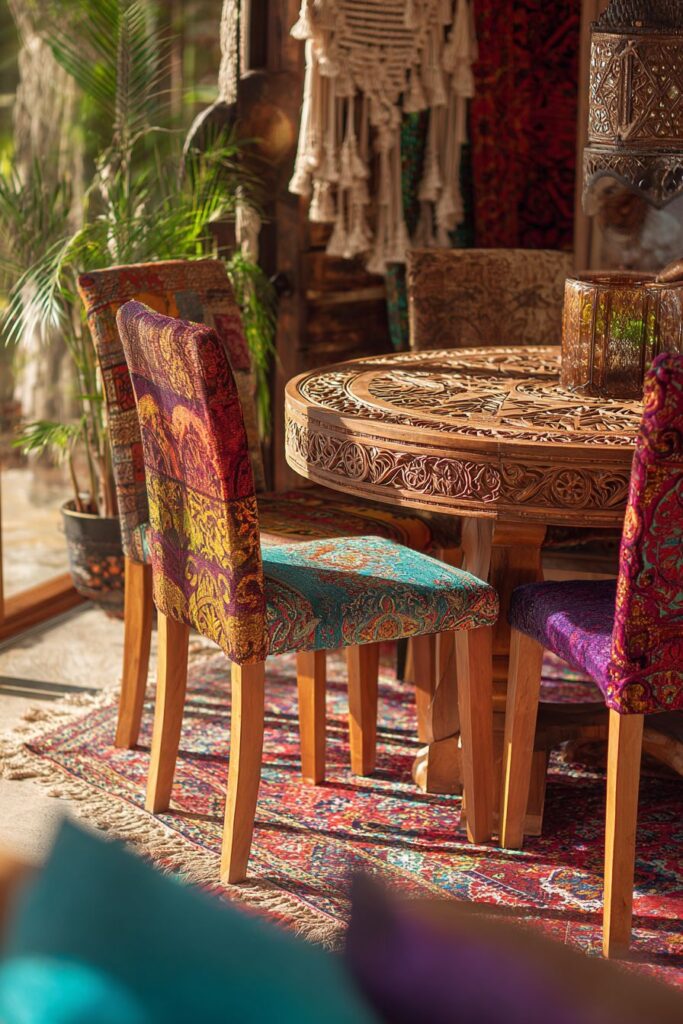
Plants in woven baskets bring life and natural elements into the space while adding various heights and textures that contribute to the collected aesthetic. Eclectic lighting fixtures, from pendant lights with intricate metalwork to table lamps with colorful shades, provide illumination at multiple levels while contributing to the room’s artistic atmosphere. Natural light filtering through beaded curtains creates dappled shadows that dance across the surfaces, adding movement and mystique to this globally inspired sanctuary.

Key Design Tips:
- Choose hand-carved furniture that showcases traditional craftsmanship and global influences
- Mix colorful upholstery on vintage chairs to create collected-over-time authenticity
- Layer textiles abundantly through rugs, wall hangings, and various fabric elements
- Incorporate plants at various heights to add life and natural texture
- Use beaded or filtered window treatments to create interesting light patterns
11. Rustic Live-Edge Oak Organic Beauty
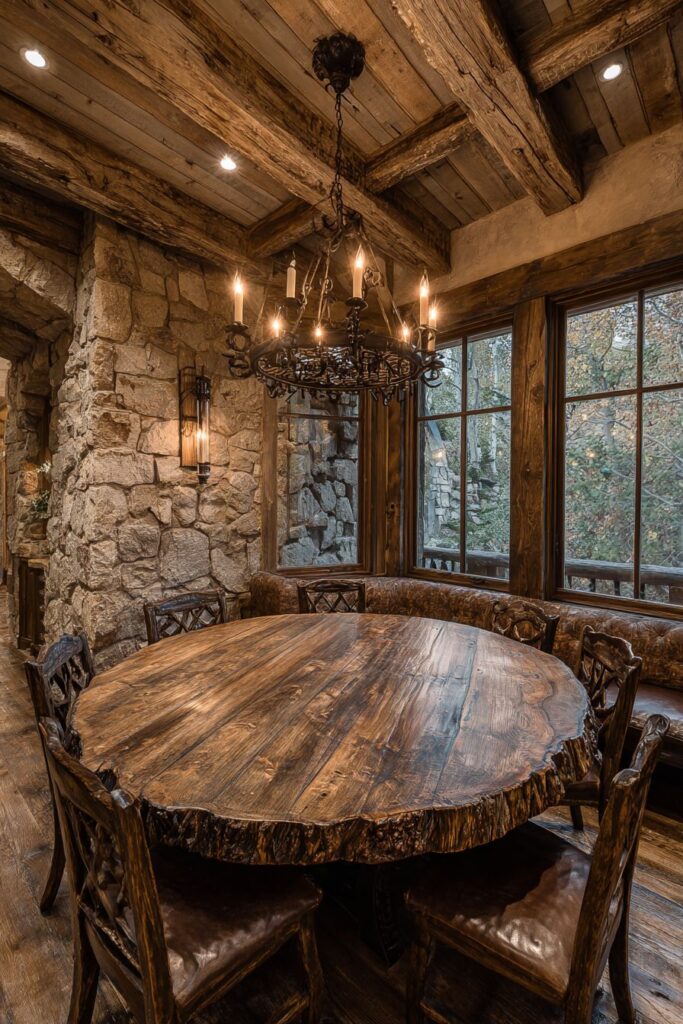
Nature’s artistry takes center stage with this live-edge oak round table that celebrates the tree’s original form through preserved bark inclusions and flowing grain patterns that seem to move like water across the surface. Each curve and natural edge tells the story of the tree’s growth, creating a unique piece that cannot be replicated. The substantial thickness of the wood slab demonstrates the craftsperson’s respect for the material’s natural beauty while providing the durability necessary for generations of family gatherings.
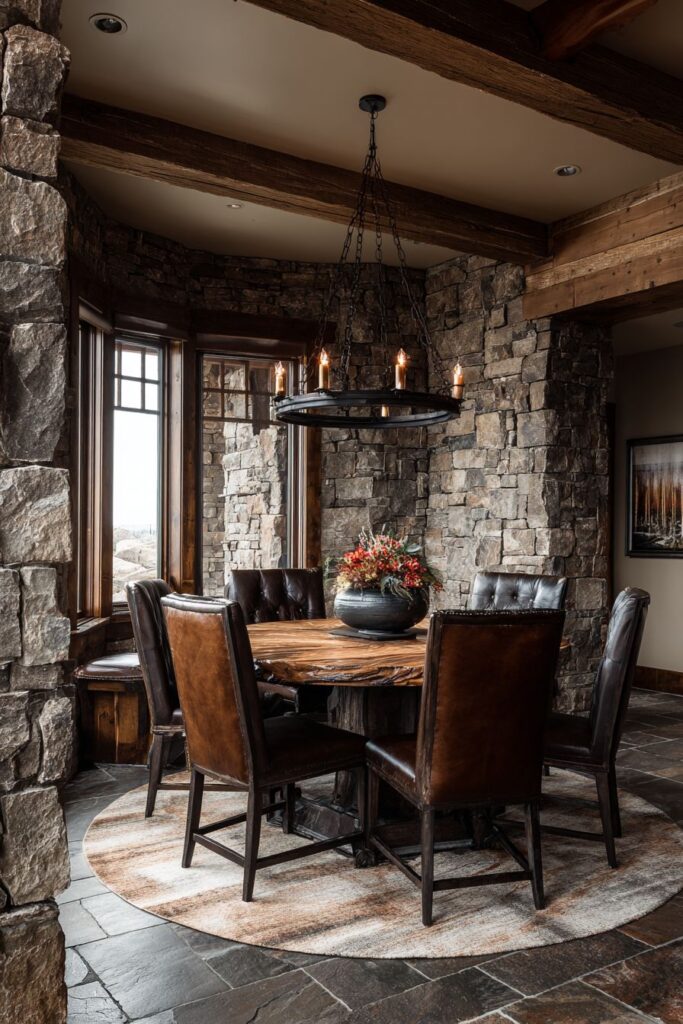
Wrought iron chairs with leather seats provide the perfect complement to the organic table design, their industrial craftsmanship creating an interesting contrast with the natural wood while maintaining the rustic aesthetic through honest materials and traditional techniques. The leather seats develop character through use, their patina deepening over time to create the authentic aged appearance that defines quality rustic furniture.
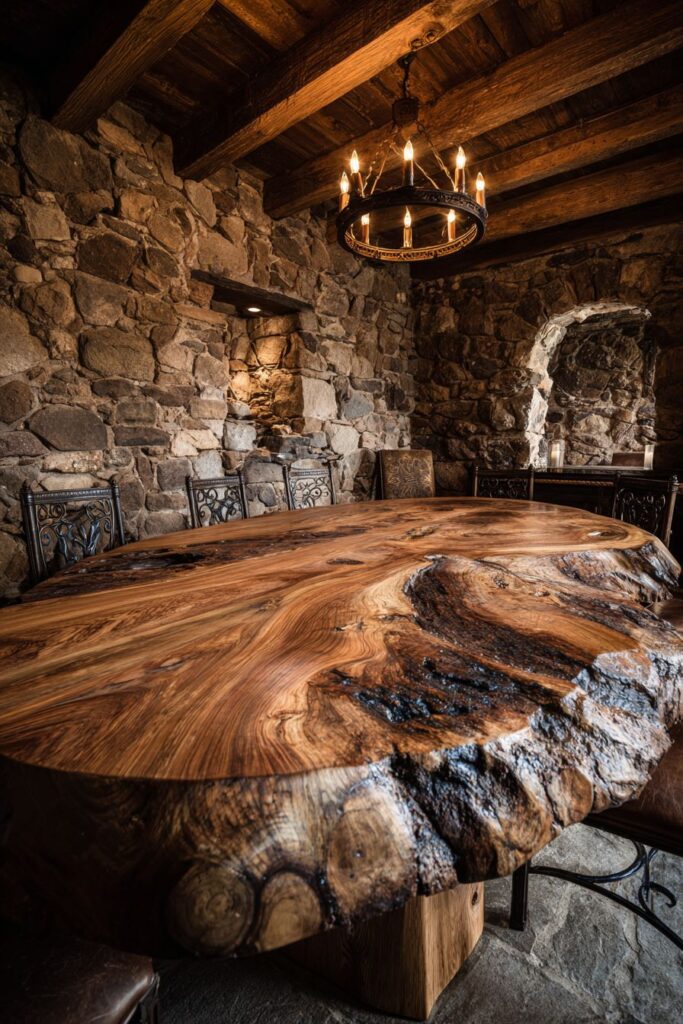
A stone accent wall adds geological texture that harmonizes with the wood’s organic forms while providing a dramatic backdrop that emphasizes the dining area’s connection to natural elements. Wooden beam ceilings complete the lodge-like atmosphere, their rough-hewn surfaces adding architectural interest that references traditional cabin construction. A wrought iron chandelier with candle-style bulbs provides warm ambient lighting that flickers like firelight, creating the cozy atmosphere perfect for intimate dining experiences.
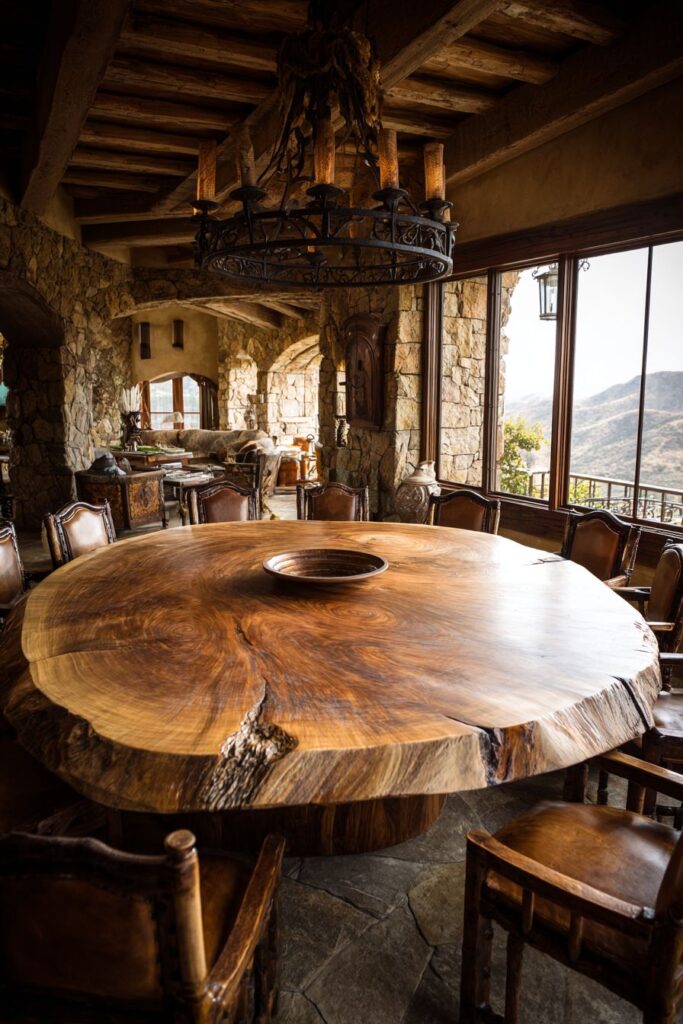
Key Design Tips:
- Preserve natural wood edges to celebrate the tree’s original form and growth patterns
- Choose wrought iron accents for authentic rustic character and durability
- Incorporate stone elements to add geological texture and natural material variety
- Use exposed wooden beams to reference traditional cabin construction
- Select candle-style lighting to create warm, flickering ambiance reminiscent of firelight
12. Transitional Grey and Cream Balance
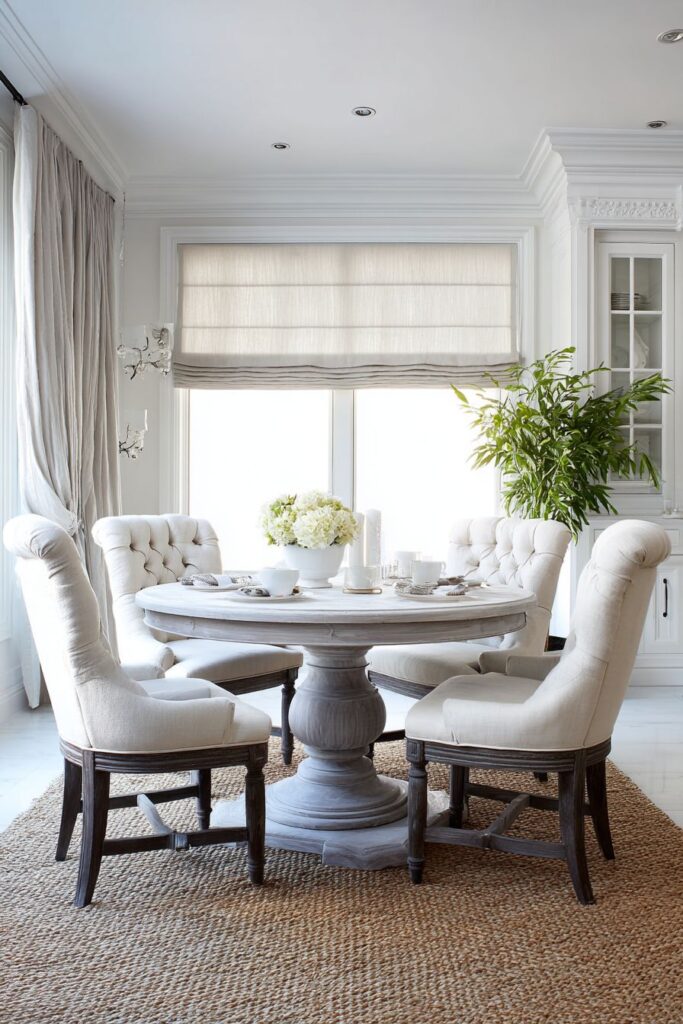
Perfect harmony between traditional and contemporary design elements defines this transitional dining space, where a painted grey round table with a turned pedestal base bridges classic furniture forms with modern color sensibilities. The soft grey finish provides sophisticated neutrality while the turned base references traditional woodworking techniques, creating a piece that feels both timeless and current. Tufted dining chairs in cream linen with dark wood frames continue the balanced approach, offering traditional button-tufted comfort within clean-lined contemporary silhouettes.
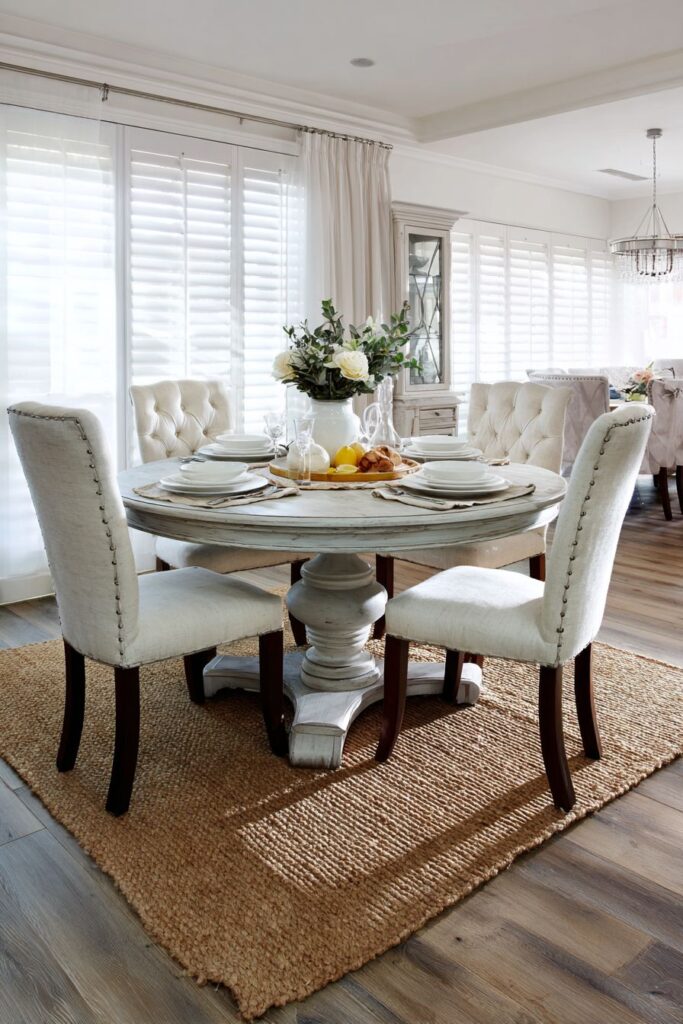
Crown molding and traditional millwork provide architectural interest that references classic interior design, while contemporary lighting fixtures prevent the space from feeling overly formal or dated. This careful balance allows homeowners to incorporate antique or traditional elements alongside modern conveniences and aesthetics. The result feels collected over time rather than decorated all at once, creating the authentic layered look that defines successful transitional design.
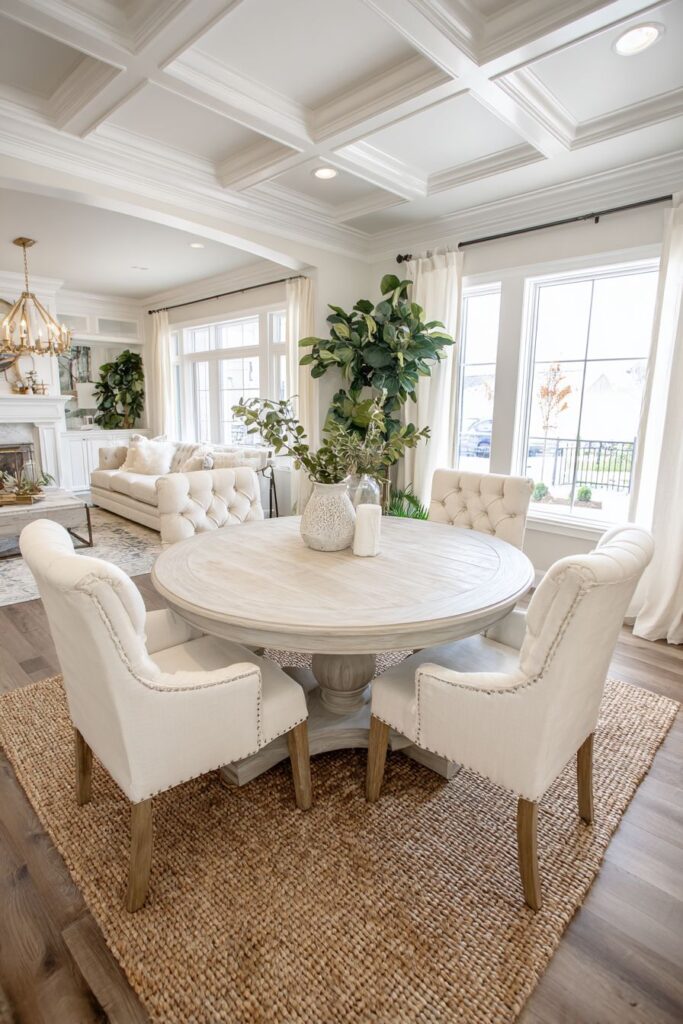
A sisal rug in natural tones grounds the neutral palette while adding organic texture that complements both traditional and contemporary elements. Soft daylight filtering through roman shades creates gentle illumination that changes throughout the day while maintaining privacy and style. The controlled natural light prevents harsh shadows while highlighting the subtle variations in the grey and cream color scheme.
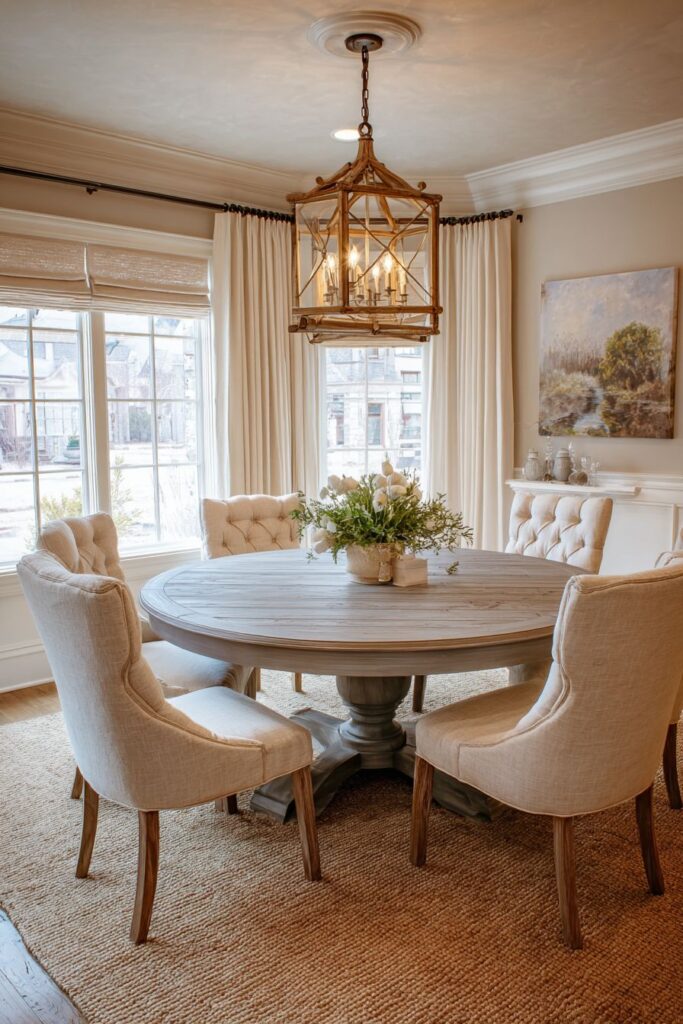
Key Design Tips:
- Use painted finishes in sophisticated neutrals to modernize traditional furniture forms
- Mix traditional architectural details with contemporary lighting for balanced aesthetics
- Choose natural fiber rugs that complement both classic and modern elements
- Control natural light with roman shades for soft, flattering illumination
- Select tufted upholstery in neutral tones for timeless comfort and style
13. Maximalist Antique Marble Opulence
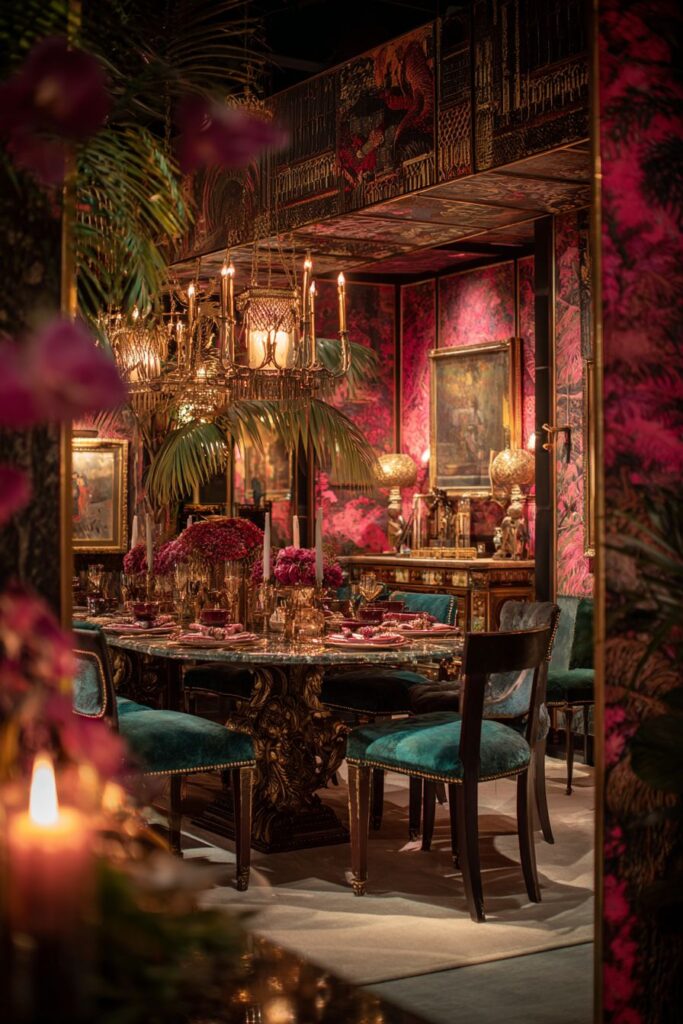
Abundance and luxury define this maximalist approach to dining room design, where an antique marble-top round table on ornate carved base serves as the centerpiece for a richly layered environment. The marble’s dramatic veining creates natural artwork that changes with the light, while the carved base demonstrates the elaborate craftsmanship that defined luxury furniture of bygone eras. Velvet dining chairs in jewel tones, including emerald, sapphire, and ruby create a rainbow of rich colors that celebrate abundance over restraint.
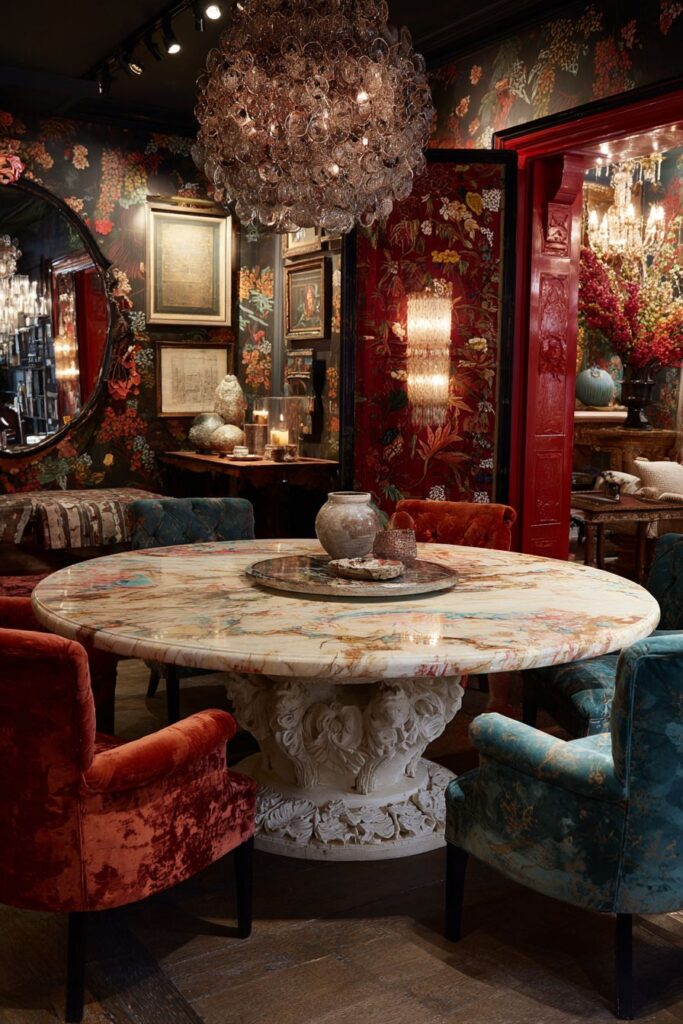
Bold wallpaper creates an immersive environment that embraces pattern and color rather than shying away from visual complexity. The carefully chosen design complements rather than competes with the ornate furniture, creating a cohesive whole that demonstrates how maximalist design requires careful curation rather than random accumulation. Multiple lighting sources including sconces and chandeliers, provide layered illumination that highlights different aspects of the rich environment throughout the day and evening.
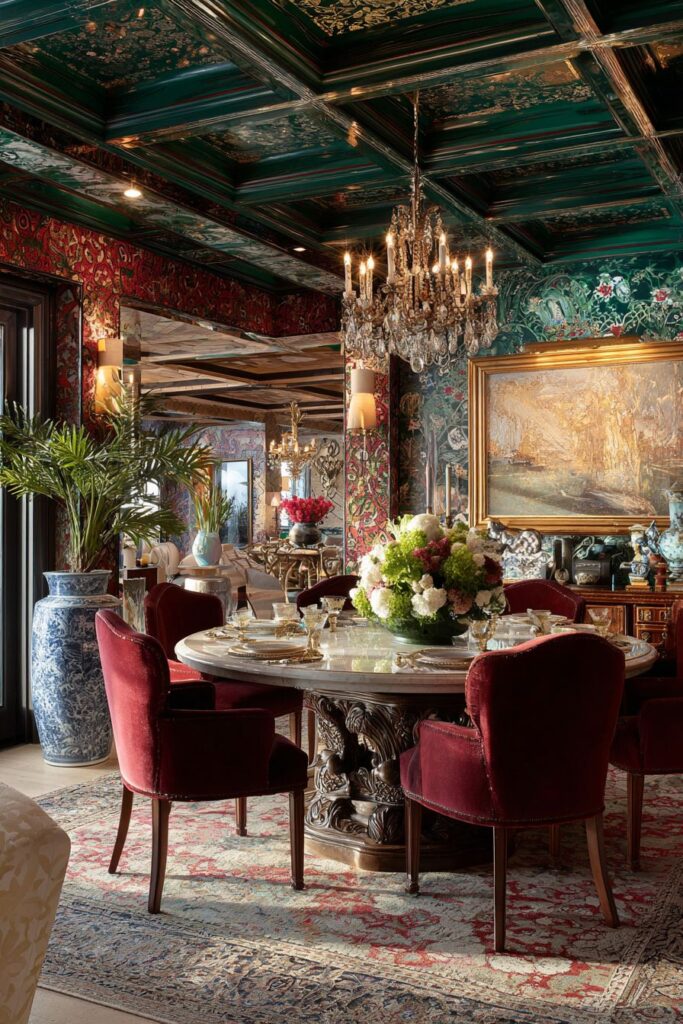
Collected artwork covers the walls in a gallery-style arrangement that tells the story of the homeowner’s travels and interests. This personal approach to decoration creates spaces that feel lived-in and loved rather than sterile or impersonal. The multiple patterns and textures coexist harmoniously through shared color stories and careful attention to scale and proportion, proving that maximalism requires as much discipline as minimalism.
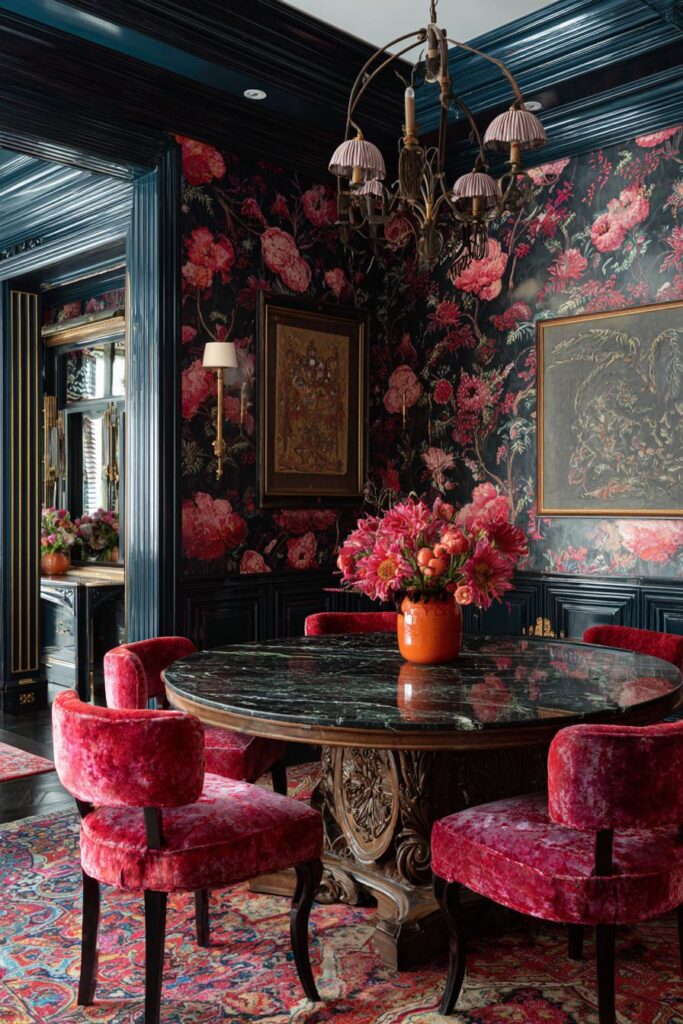
Key Design Tips:
- Choose antique furniture with elaborate details that serve as conversation pieces
- Use jewel tone upholstery to create rich color stories that celebrate abundance
- Layer multiple lighting sources to highlight different aspects of complex environments
- Create gallery walls with collected artwork that reflects personal interests and travels
- Balance patterns through shared color stories to maintain cohesion in complex spaces
14. Minimalist White Oak Zen
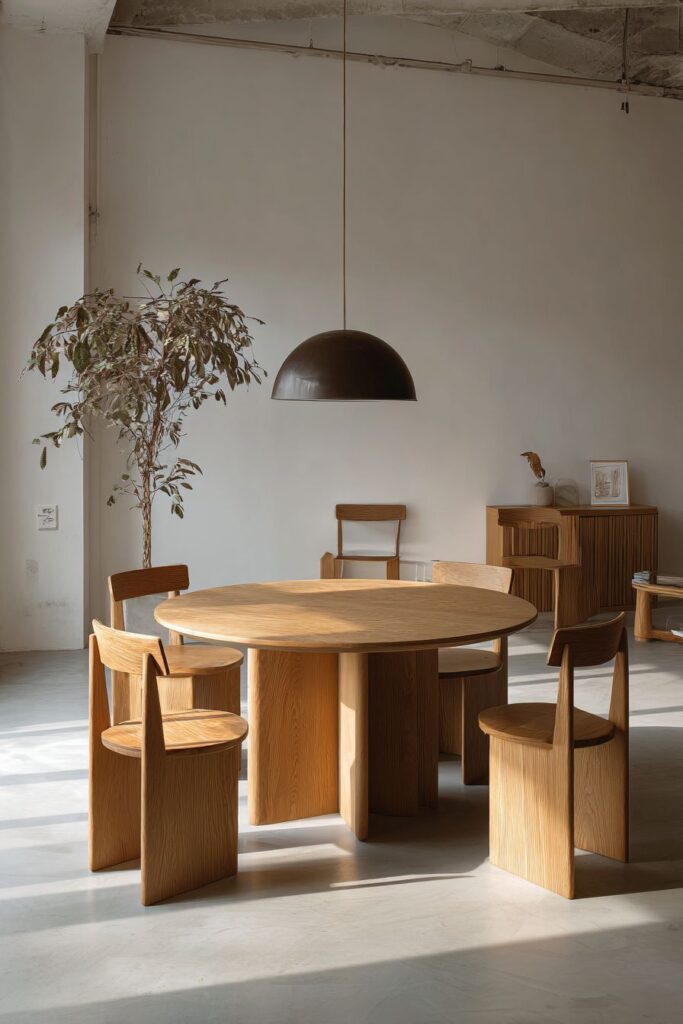
Serenity emerges from restraint in this minimalist dining space, where a simple white oak round table with subtle grain on a clean pedestal base embodies the philosophy that beauty comes from purity of form and honest materials. The pale wood’s natural grain provides all necessary visual interest, its flowing patterns creating organic artwork that changes with the light throughout the day. Four identical chairs in matching natural wood create perfect symmetry that calms the mind and focuses attention on the essential elements.
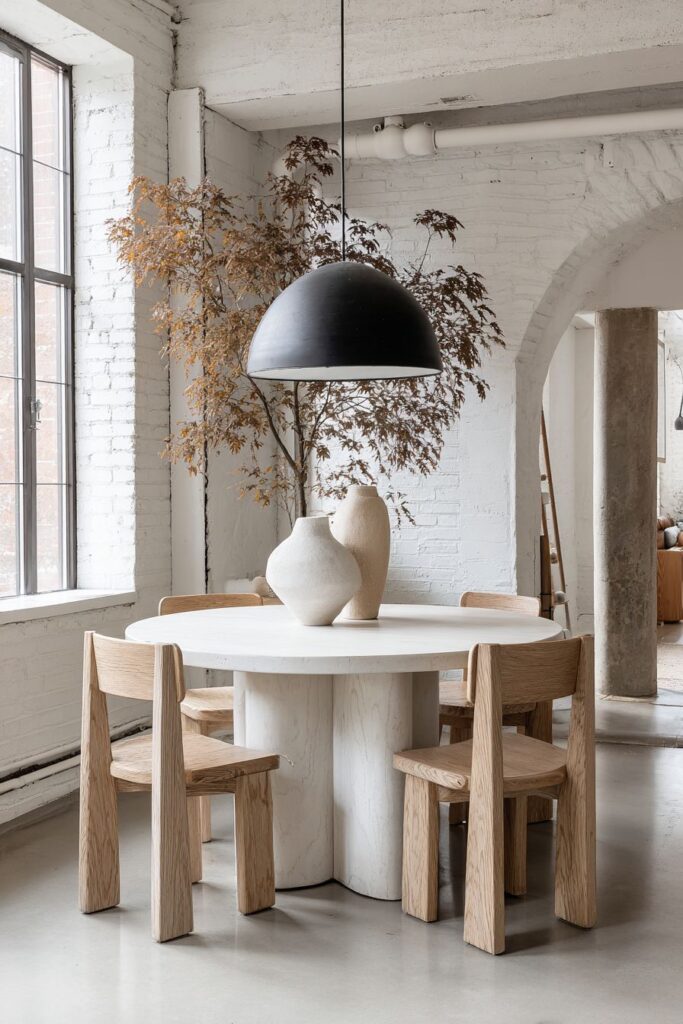
White walls and polished concrete floors establish a neutral backdrop that allows the wood’s natural beauty to shine without competition. The hard surfaces create acoustic clarity while reflecting light throughout the space, maximizing the impact of both natural and artificial illumination. A single oversized pendant light in matte black provides necessary task lighting while serving as the only decorative element beyond the essential furniture.
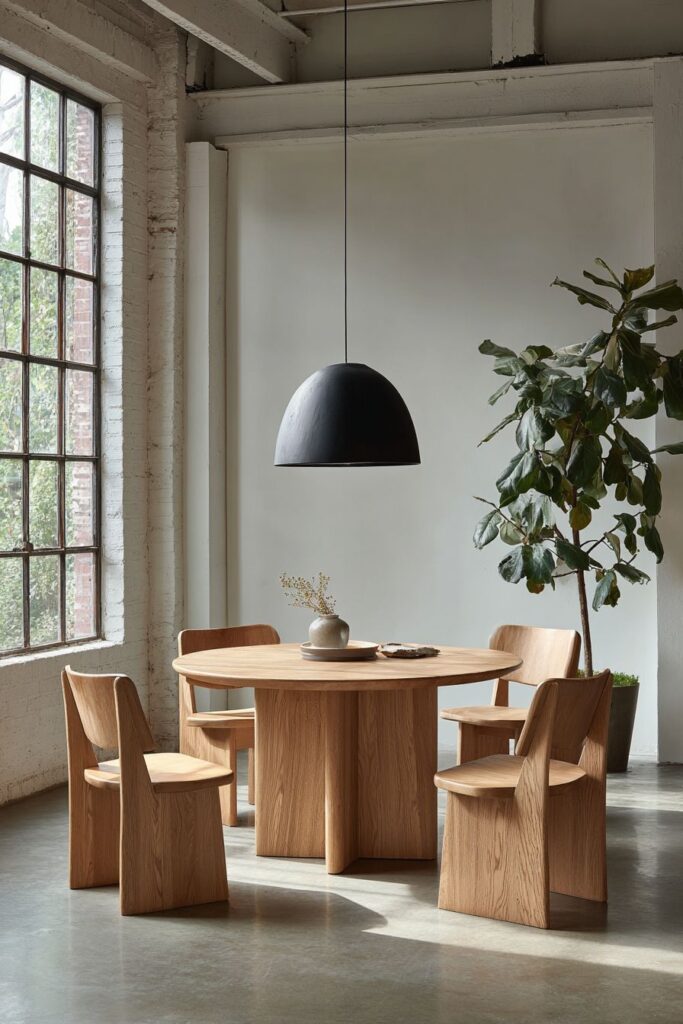
One carefully chosen statement plant serves as the sole decorative accent, its living presence adding life and natural movement to the serene composition. This restraint requires confidence and commitment to the minimalist philosophy, but the result creates spaces of profound calm that offer refuge from our increasingly complex world. The uncluttered environment allows the mind to rest while the high-quality materials satisfy our need for sensory richness.
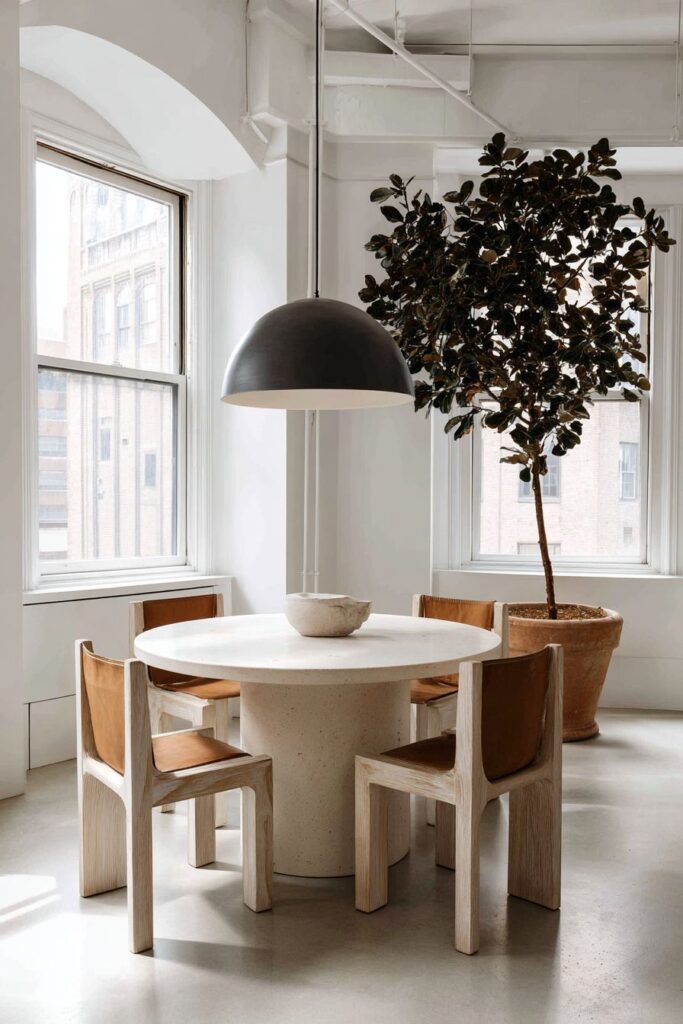
Key Design Tips:
- Choose furniture with clean lines that showcase natural material beauty
- Maintain monochromatic color schemes to create visual calm and unity
- Use single statement elements like oversized lighting to provide focal points
- Incorporate one living plant to add life without cluttering the serene environment
- Invest in quality materials to provide sensory richness within minimal compositions
15. French Country Sage Green Authenticity
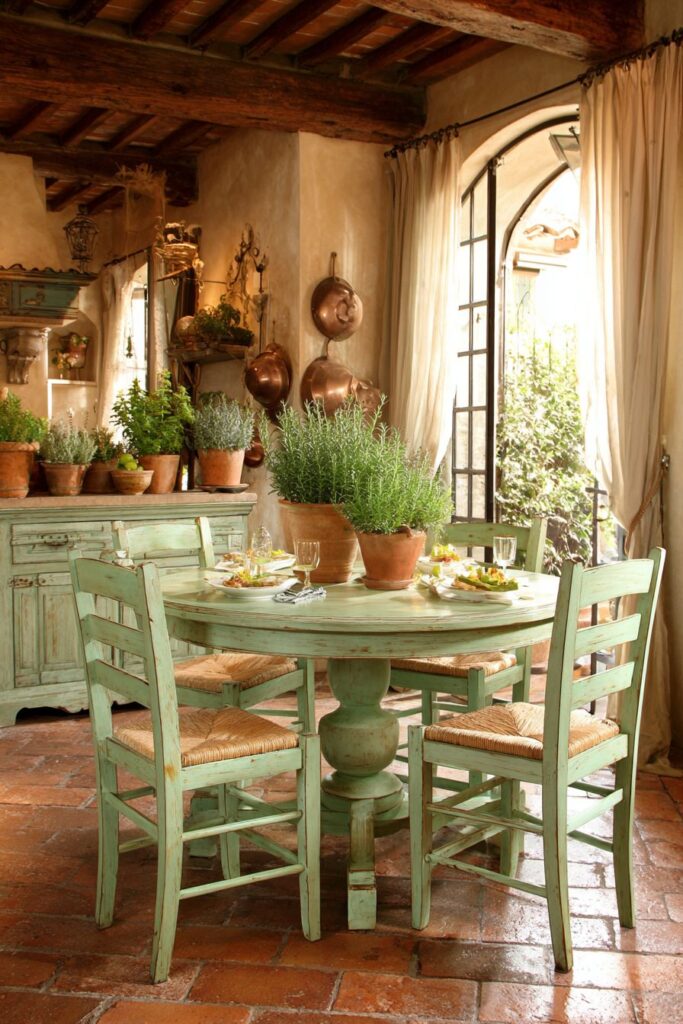
Provincial charm radiates from this French country dining space, where a distressed painted round table in soft sage green embodies the lived-in comfort that defines authentic European countryside aesthetics. The painted finish shows gentle wear patterns that suggest decades of family gatherings, creating the authentic patina that cannot be rushed or manufactured. Ladder-back chairs with traditional rush seats provide comfortable seating that references centuries-old French furniture making traditions while maintaining the rustic simplicity that makes country style so enduringly appealing.

Exposed wooden beams overhead and stone floors underfoot create architectural authenticity that transports diners to a Provençal farmhouse where generations of families have shared meals. These architectural elements provide texture and visual weight that ground the lighter furniture elements while maintaining the connection to traditional building techniques. The natural materials age beautifully, developing character and patina that enhance rather than diminish their appeal over time.
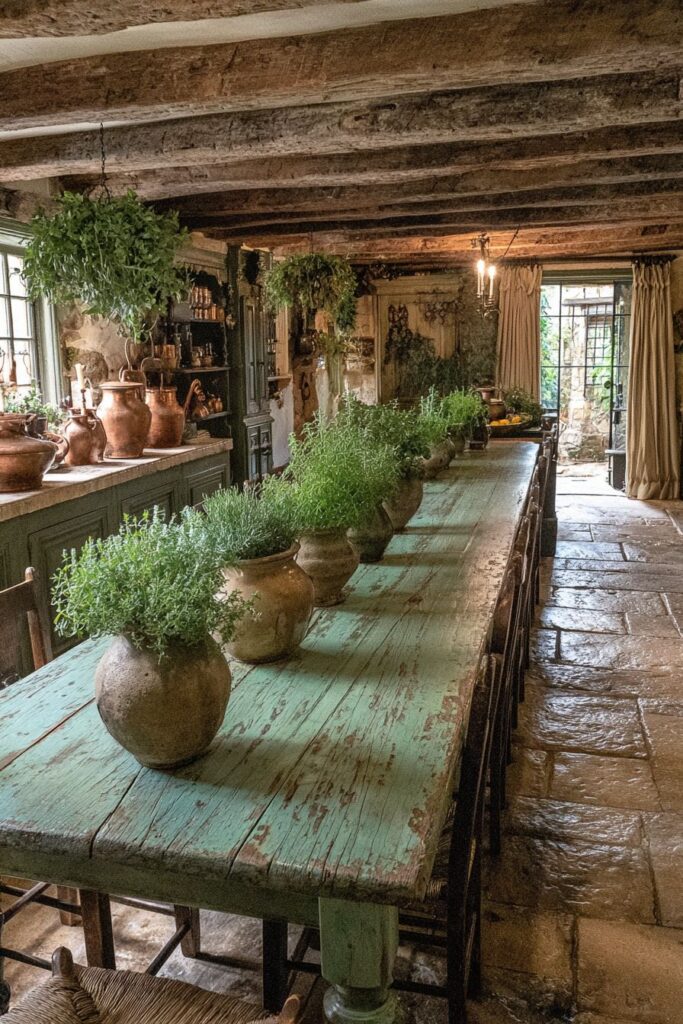
Natural herbs growing in earthenware vessels serve as both centerpiece and functional kitchen garden, bringing the French tradition of growing herbs for cooking directly to the dining table. Their fresh scents enhance the dining experience while providing ready access to flavor enhancers for meals. Warm natural lighting filtering through linen curtains creates the soft, diffused illumination characteristic of French country interiors, where harsh artificial lighting is avoided in favor of gentle, flattering natural light.
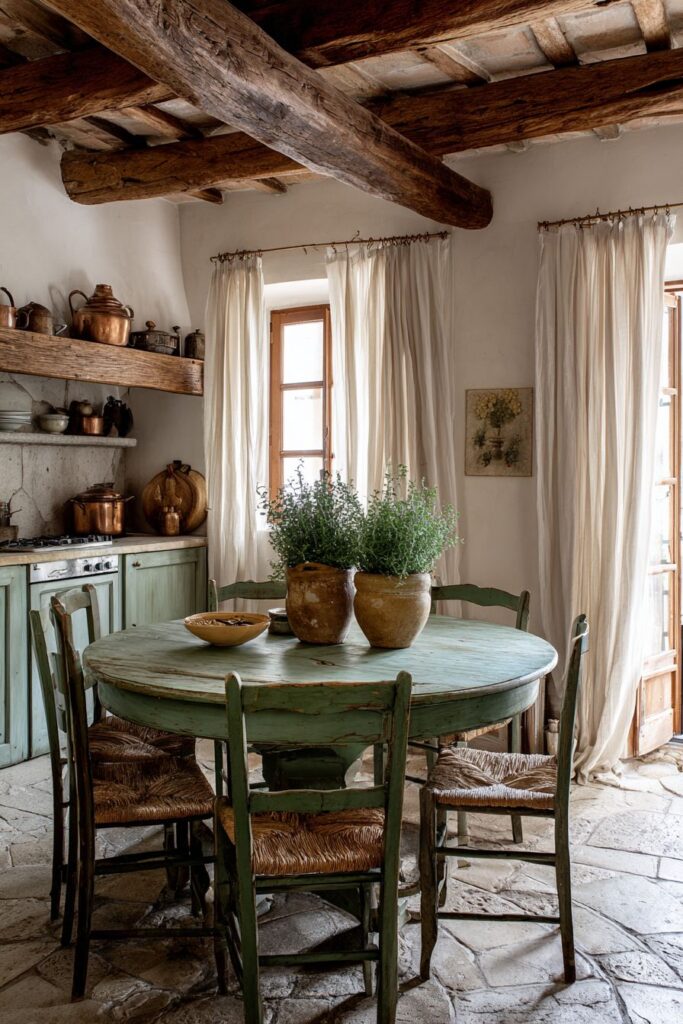
Key Design Tips:
- Use distressed paint finishes that show authentic wear patterns and aged character
- Choose traditional rush-seat chairs for authentic French furniture construction
- Incorporate exposed architectural elements like wooden beams and stone floors
- Grow herbs in earthenware containers for functional beauty and fresh scents
- Filter natural light through linen to create soft, flattering illumination
16. Modern Farmhouse Reclaimed and Refined

Contemporary sensibilities meet rustic charm in this modern farmhouse dining space, where a reclaimed wood round table on a painted white pedestal base perfectly embodies the style’s marriage of old and new elements. The weathered wood top tells stories of its previous life while the crisp white base provides fresh contrast that prevents the space from feeling too rustic or dated. Mixed seating, including both upholstered and wooden chairs, creates visual interest while maintaining the eclectic, collected-over-time aesthetic that defines authentic farmhouse style.

A shiplap accent wall painted in soft white provides textural interest without overwhelming the space, its horizontal lines creating subtle movement that enhances the room’s relaxed atmosphere. Vintage-inspired lighting fixtures with modern functionality provide the best of both worlds – authentic character with contemporary reliability and performance. Galvanized metal accents throughout the space reference farming heritage while providing durable, practical elements.
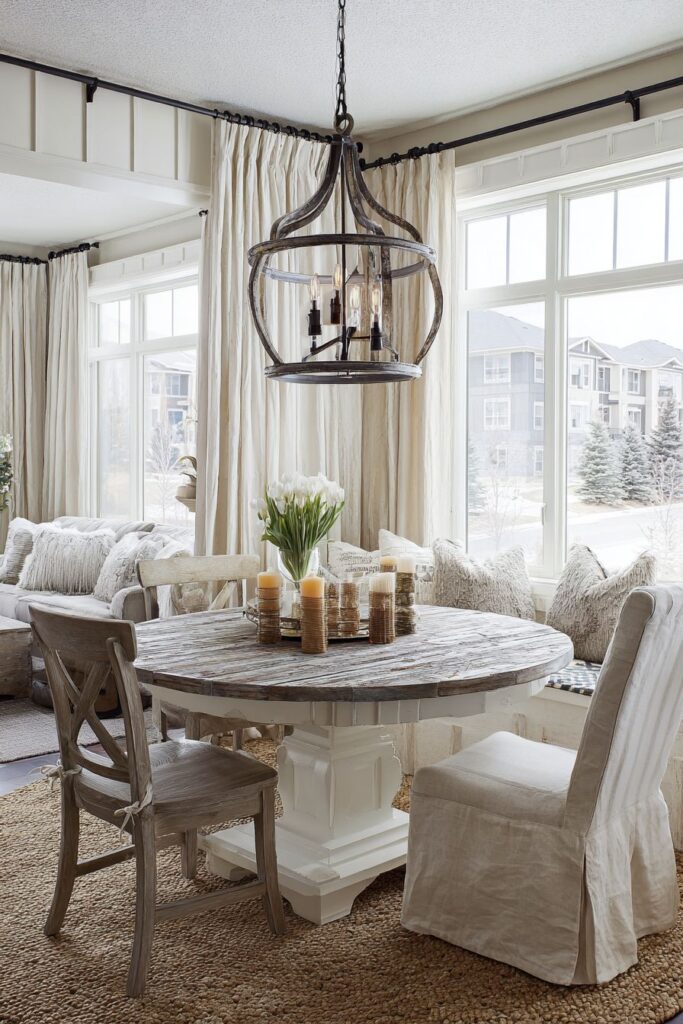
A braided jute rug anchors the seating area with natural texture that complements the reclaimed wood while providing comfort underfoot. Multiple windows fill the space with bright, welcoming natural light that changes throughout the day, creating the ever-shifting illumination that makes farmhouse interiors feel so alive and connected to the natural world. This abundance of natural light prevents the rustic elements from feeling dark or heavy.
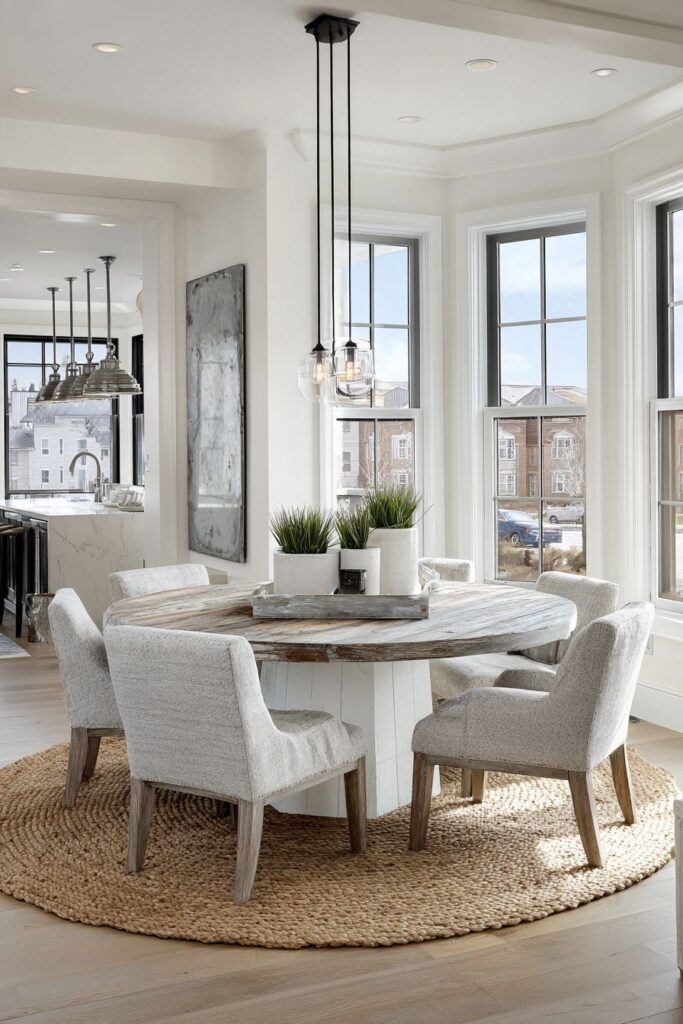
Key Design Tips:
- Pair reclaimed wood with painted bases for fresh contrast and modern appeal
- Mix upholstered and wooden seating for collected, eclectic authenticity
- Use shiplap as accent walls to add texture without overwhelming spaces
- Choose vintage-inspired lighting with modern functionality for best performance
- Maximize natural light to prevent rustic elements from feeling dark or heavy
17. Art Deco Black Lacquer Glamour
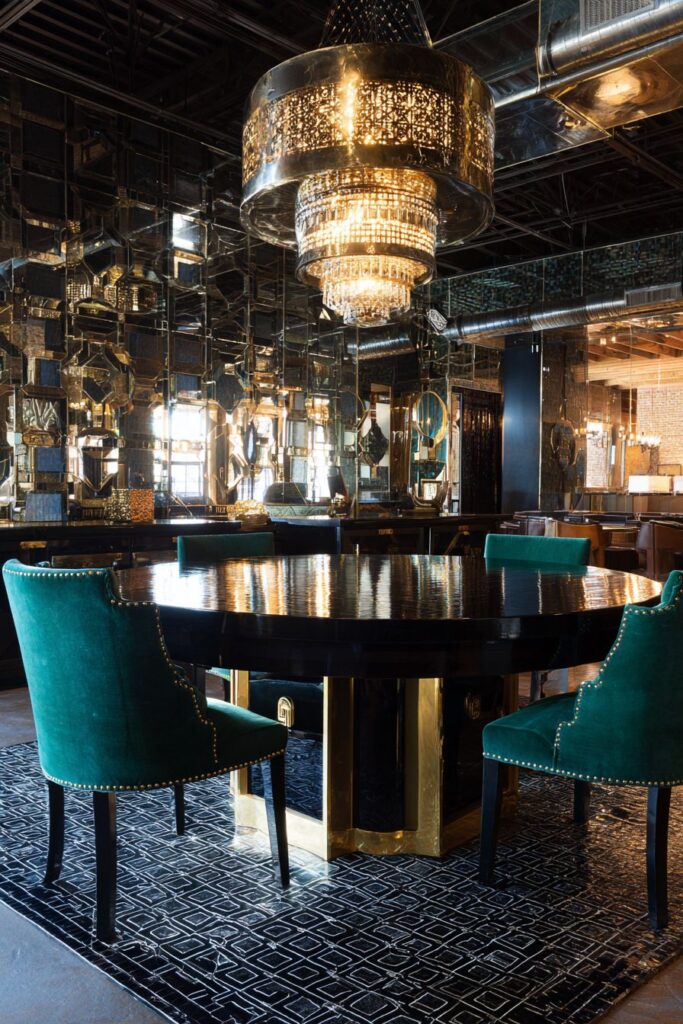
Sophisticated glamour from the roaring twenties returns in this art deco dining space, where a black lacquer round table with gold leaf accents on a geometric base channels the era’s love for luxury materials and bold geometric forms. The high-gloss lacquer finish reflects light like a mirror while the gold leaf details catch and amplify illumination, creating a piece that serves as both functional furniture and sculptural art. Chairs upholstered in emerald velvet with brass nailheads continue the luxurious material palette while providing the jewel-toned color that defines the period’s bold aesthetic.
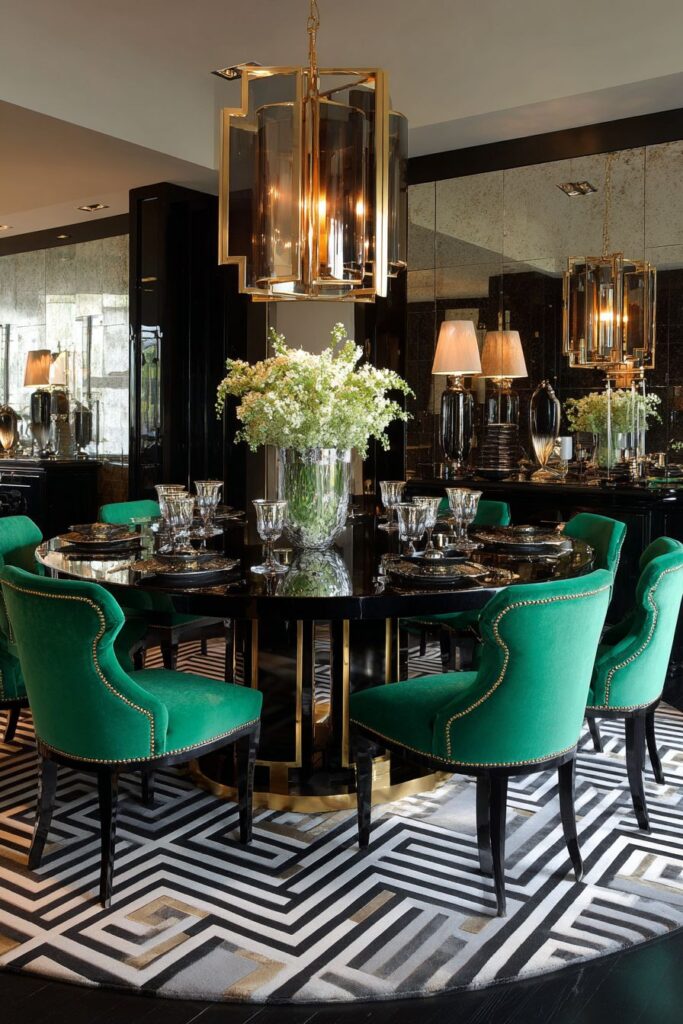
Mirrored accent walls multiply light and space while creating the glamorous atmosphere that transports diners from everyday concerns into realms of luxury and sophistication. The reflective surfaces create infinite visual depth while allowing the geometric patterns and metallic accents to sparkle throughout the space. A sculptural lighting fixture embodies the era’s embrace of modern technology and artistic form, providing both illumination and artistic focal point.
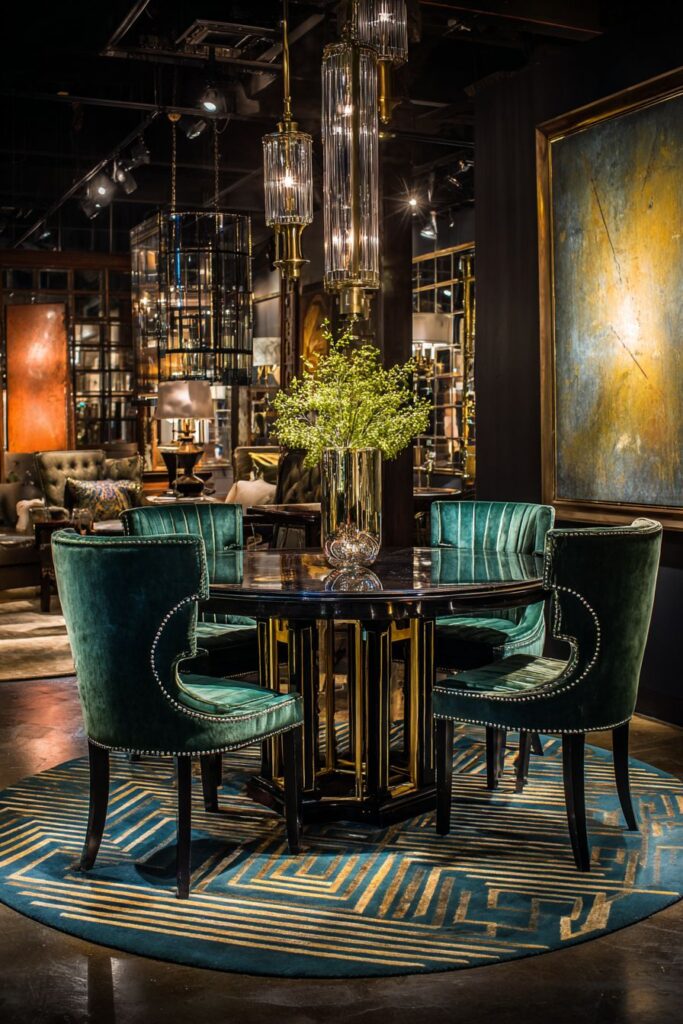
Geometric patterned rugs underfoot reference the mathematical precision that influenced art deco design while adding pattern that complements rather than competes with the bold furniture forms. Dramatic lighting creates strong contrasts between light and shadow, highlighting the reflective surfaces while creating the theatrical atmosphere that made art deco interiors feel like stage sets for glamorous living.
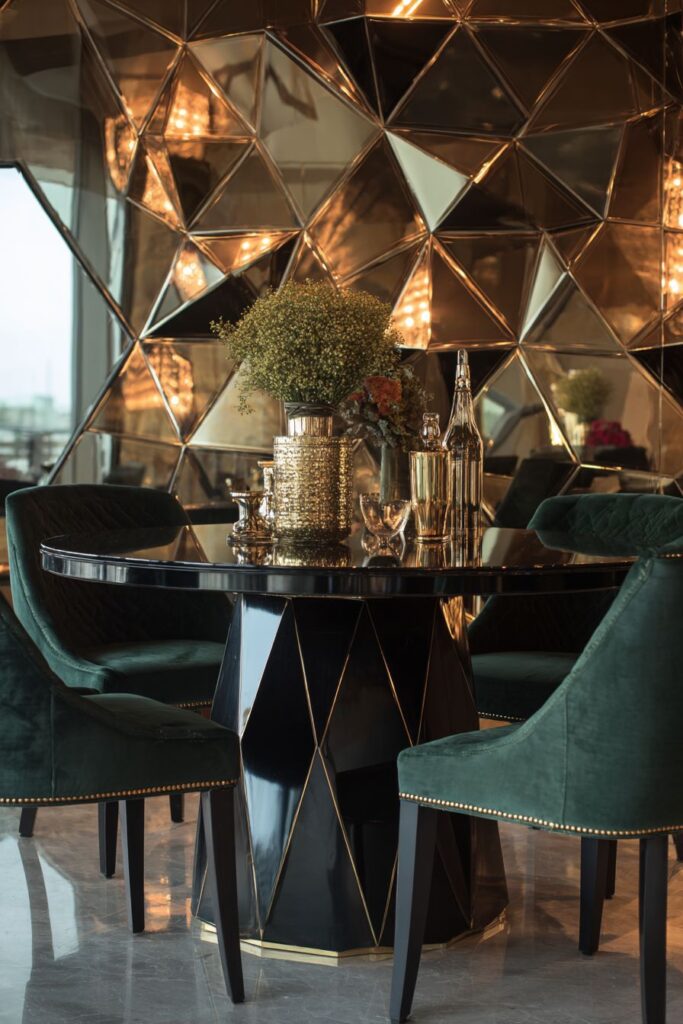
Key Design Tips:
- Choose high-gloss lacquer finishes with metallic accents for authentic period luxury
- Use emerald velvet upholstery with brass nailheads for jewel-toned sophistication
- Incorporate mirrored surfaces to multiply light and create infinite visual depth
- Select geometric patterns that reference the era’s mathematical precision
- Create dramatic lighting contrasts to highlight reflective surfaces and metallic details
18. Southwestern Mesquite Desert Warmth

Desert beauty and regional authenticity converge in this Southwestern dining space, where a mesquite wood round table displaying natural edge and distinctive grain celebrates the unique character of American desert hardwoods. The honey-colored wood features the dramatic grain patterns and natural imperfections that make each piece unique, while the natural edge preserves the tree’s original form and celebrates its desert origins. Leather chairs with wrought iron frames provide comfortable seating that references the region’s ranching heritage while maintaining the authentic materials that define Southwestern style.
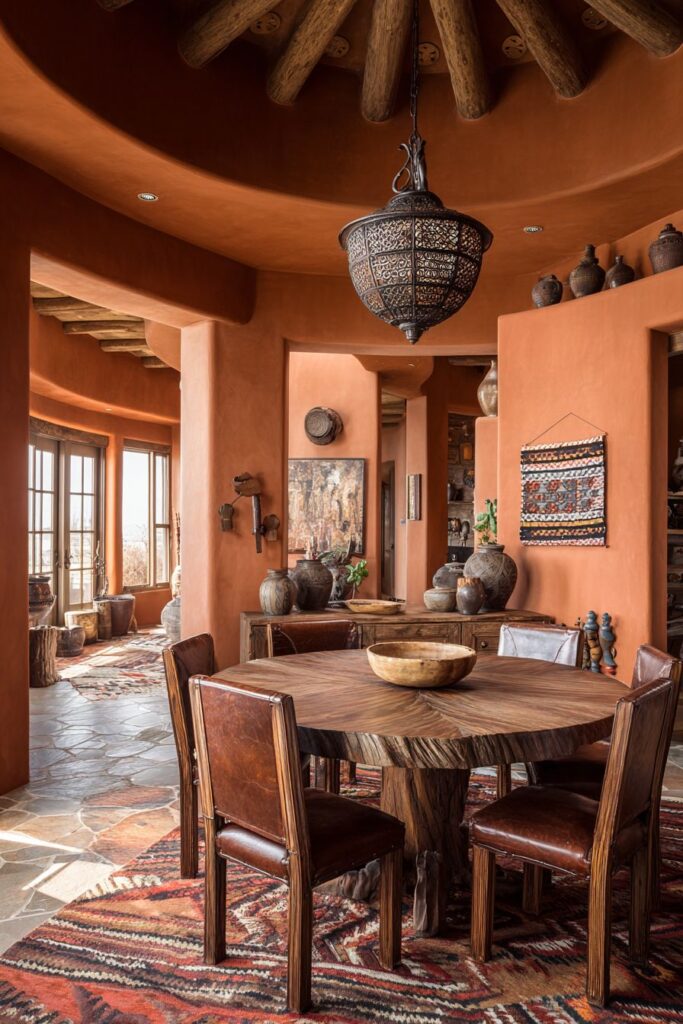
Adobe-style walls create the perfect backdrop for this regional aesthetic, their textured surface referencing traditional building techniques that have protected desert dwellers for centuries. Handwoven textiles, including Navajo rugs and Mexican blankets add layers of color and pattern that celebrate the region’s rich cultural heritage. Pottery collections displayed throughout the space showcase the ancient ceramic traditions that continue to flourish in the American Southwest.
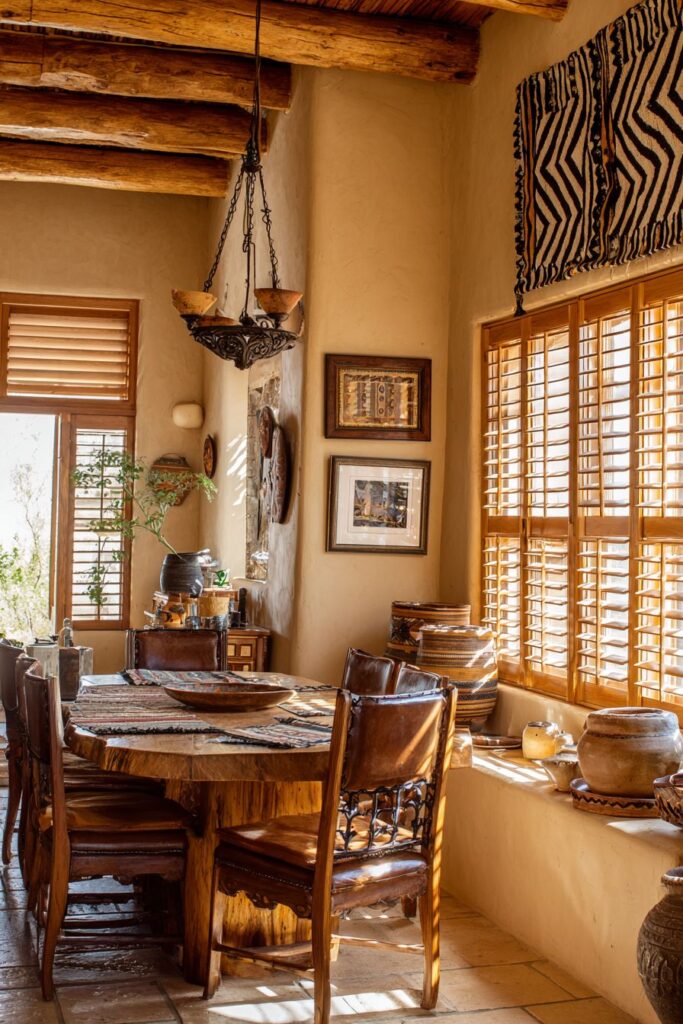
A wrought iron chandelier with mica shades provides warm ambient lighting that filters through the translucent mineral, creating the golden glow characteristic of desert sunsets. Natural desert light filtering through wooden shutters creates dramatic shadows that shift throughout the day, highlighting the wood’s grain patterns while protecting the interior from harsh midday sun. This interplay of light and shadow creates the ever-changing atmosphere that makes Southwestern interiors feel so connected to their landscape.

Key Design Tips:
- Choose mesquite wood for authentic regional material with distinctive grain patterns
- Use leather and wrought iron to reference ranching heritage and traditional craftsmanship
- Incorporate adobe-style walls for authentic textural interest and regional character
- Display handwoven textiles that celebrate the area’s rich cultural heritage
- Install mica lighting to create the golden glow of desert sunsets
19. Eclectic Vintage Tulip Personality
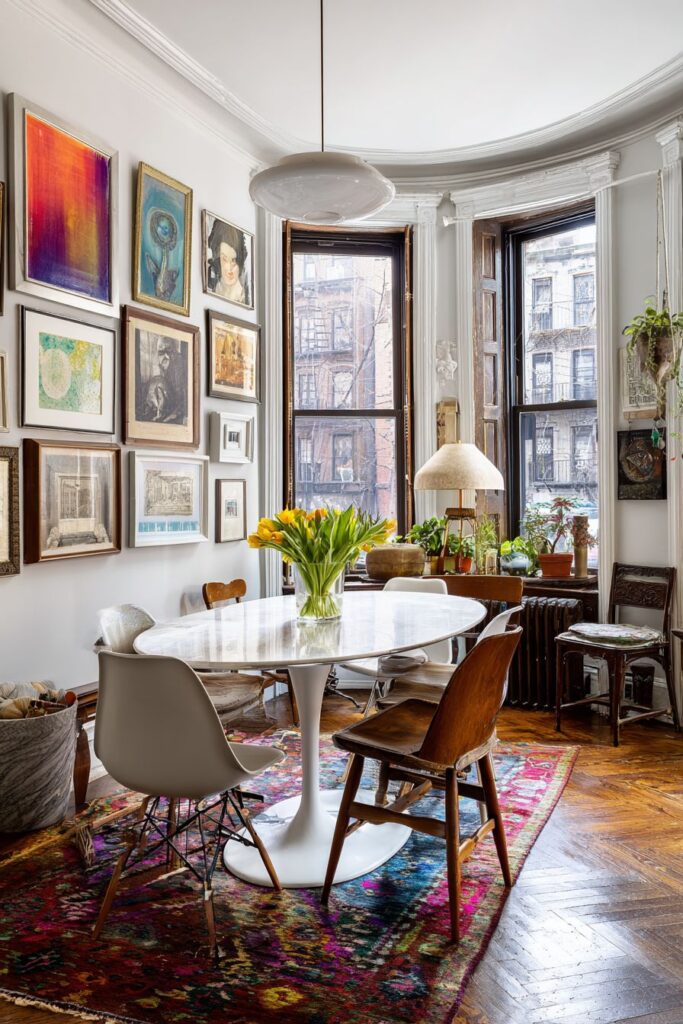
Personal collecting and curation create magic in this eclectic dining space, where a vintage tulip-style table in white serves as the neutral foundation for an ever-evolving collection of mismatched antique chairs. Each chair tells its own story, representing different periods, styles, and origins that reflect the homeowner’s travels and discoveries over time. This approach celebrates the beauty of imperfection and the joy of collecting, creating spaces that feel deeply personal and completely unique.
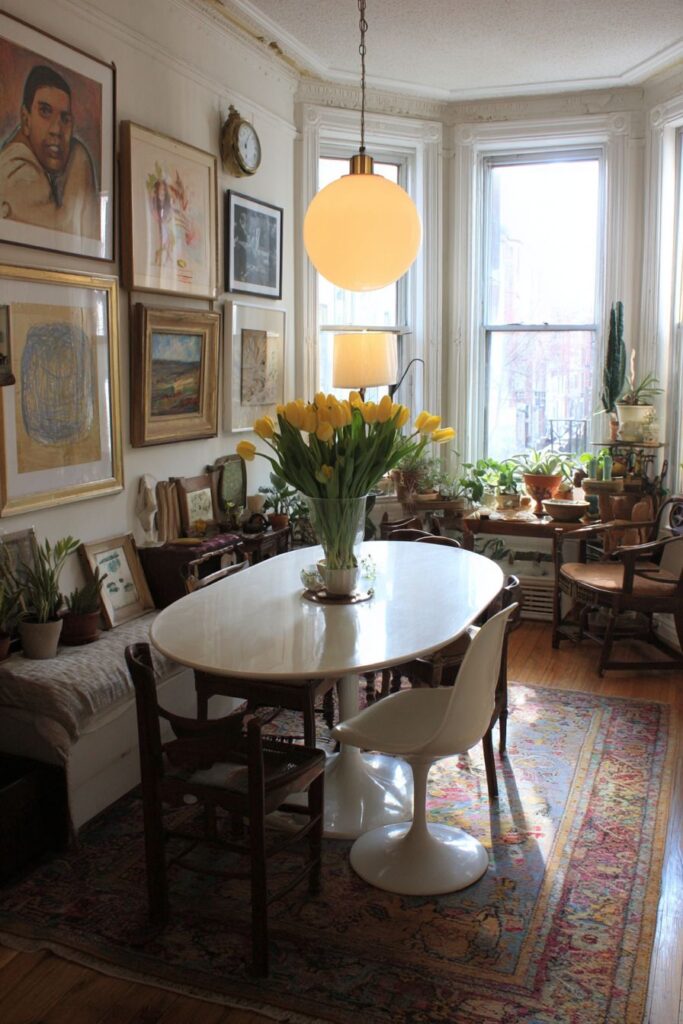
A gallery wall of varied artwork covers one wall in a salon-style arrangement that showcases paintings, photographs, and prints collected over years of exploration. The mix of frames, subjects, and artistic styles creates visual richness that rewards close examination while providing endless conversation starters. Plants at different heights throughout the space add life and natural movement, their varied containers reflecting the same eclectic collecting philosophy applied to furnishings.
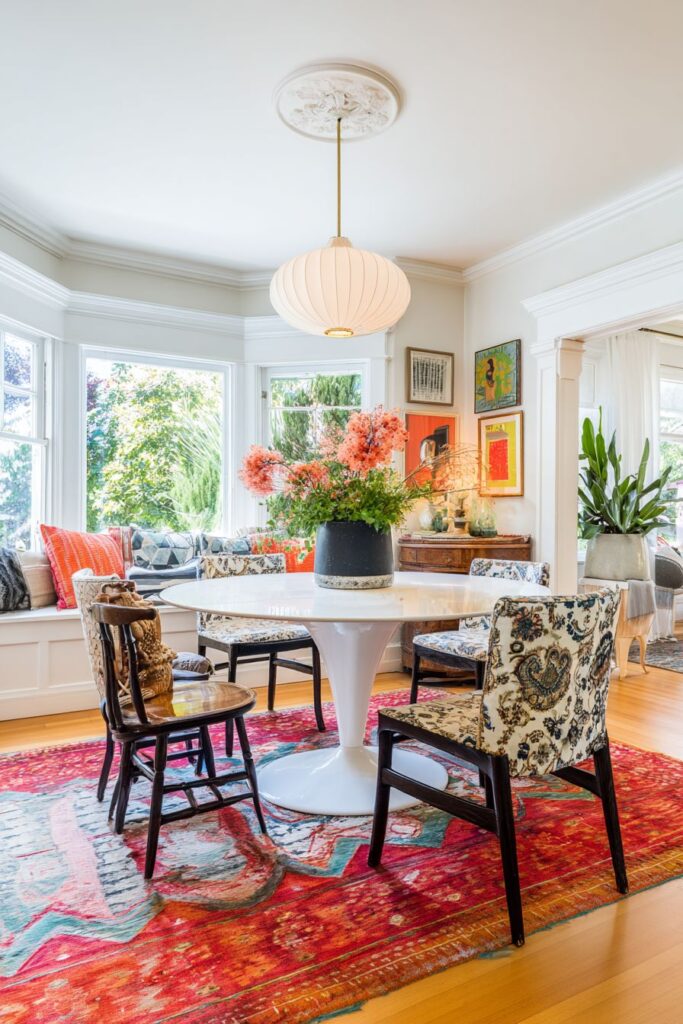
Layered lighting throughout the space includes pendant lights, table lamps, and candles that create intimate pools of illumination perfect for extended conversations. Natural lighting from a bay window supplements the artificial sources while highlighting the collection of objects that make this space feel like a lived-in sanctuary. A colorful vintage runner adds warmth to hardwood floors while introducing a pattern that complements the overall collected aesthetic.
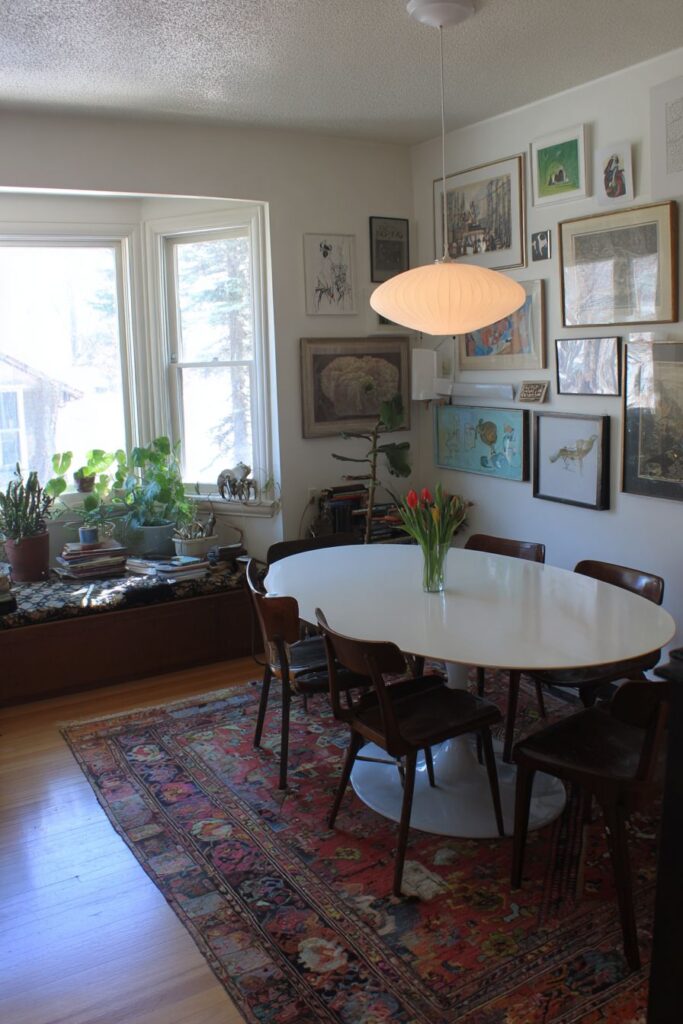
Key Design Tips:
- Collect chairs over time for authentic eclectic character and personal history
- Create gallery walls with mixed artwork that reflects personal interests and travels
- Layer lighting sources at multiple levels for intimate, flexible illumination
- Include plants at various heights to add life and natural movement to collected spaces
- Use vintage textiles to add warmth and pattern that complements eclectic furnishings
20. Luxury Marble and Burgundy Opulence
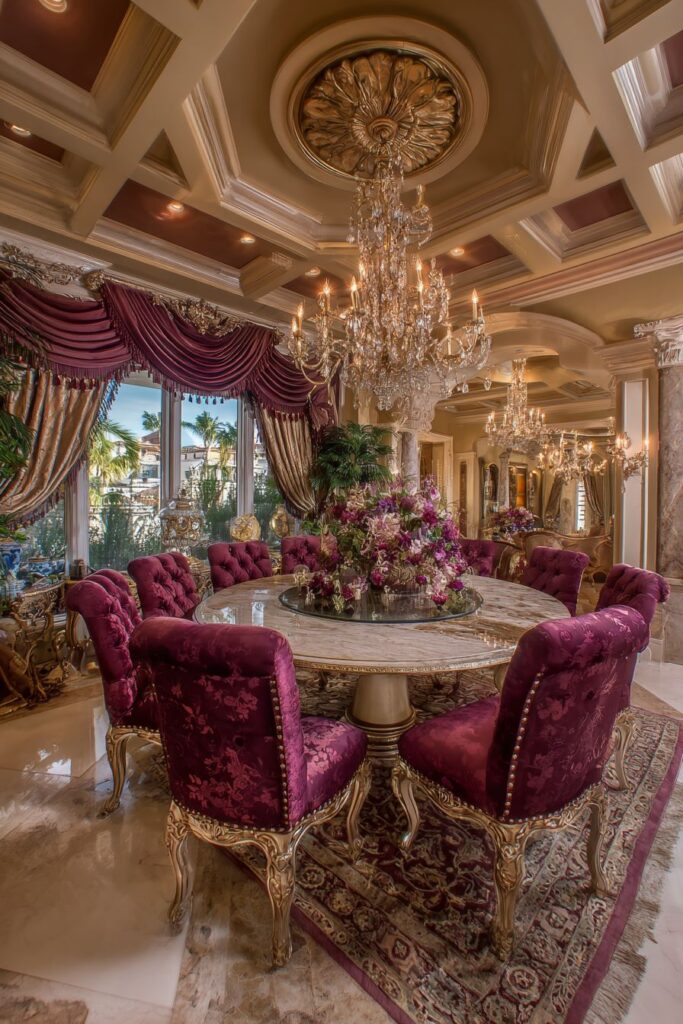
Ultimate refinement defines this luxury dining space, where a marble pedestal table with dramatic veining serves as the centerpiece for an environment dedicated to entertaining in grand style. The marble’s natural patterns create artwork that changes with the light, while its substantial presence commands respect and admiration from all who enter. Tufted dining chairs in rich burgundy leather with brass studs provide seating worthy of the magnificent table, their deep color and luxurious material creating an atmosphere of opulent comfort.
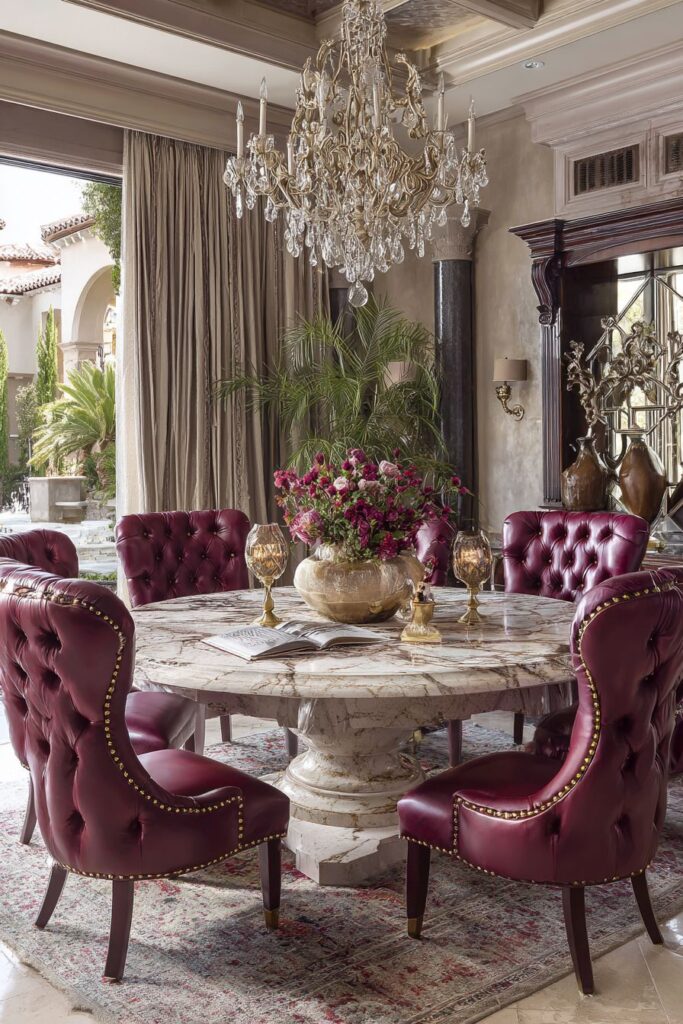
A crystal chandelier suspended above the table provides both illumination and sparkle, its faceted elements casting dancing light patterns across the marble’s surface while creating the glamorous atmosphere essential for formal entertaining. Silk drapery frames tall windows in luxurious folds that control natural light while adding layers of textile richness. The Persian rug underfoot features intricate patterns in burgundy and gold that complement the overall color scheme while adding historical depth and cultural sophistication.
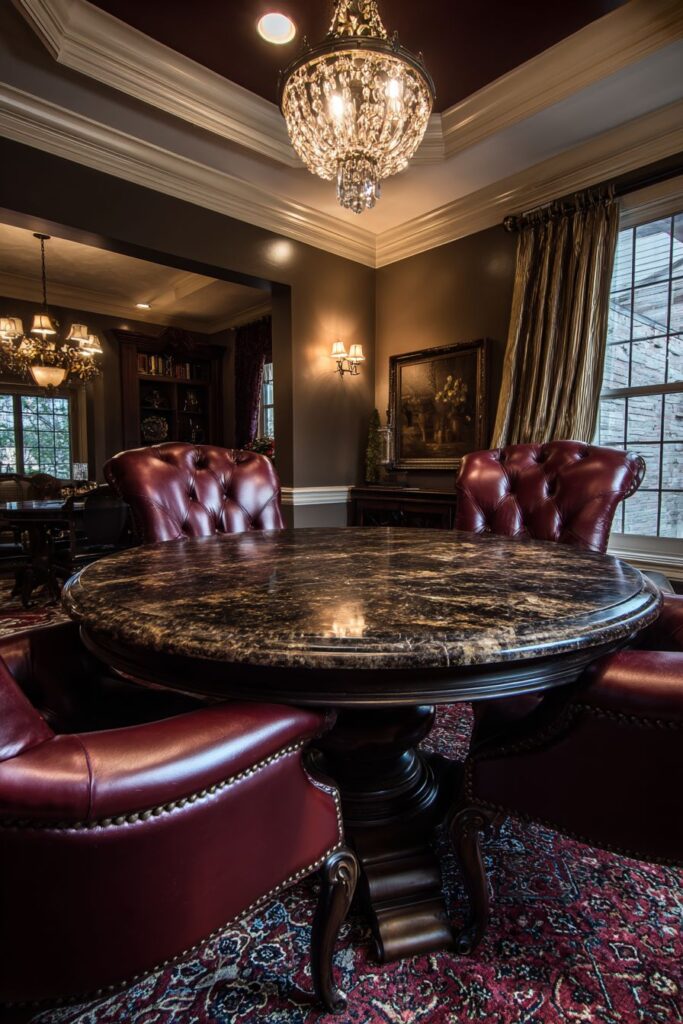
Crown molding and coffered ceiling add architectural grandeur that elevates this space beyond simple dining into the realm of formal entertainment. These classical details provide the perfect frame for the luxury furnishings while demonstrating the attention to architectural detail that defines truly elegant interiors. Layered lighting including wall sconces, supplements the chandelier, creating sophisticated ambiance that can be adjusted for different occasions, from intimate dinners to grand celebrations.
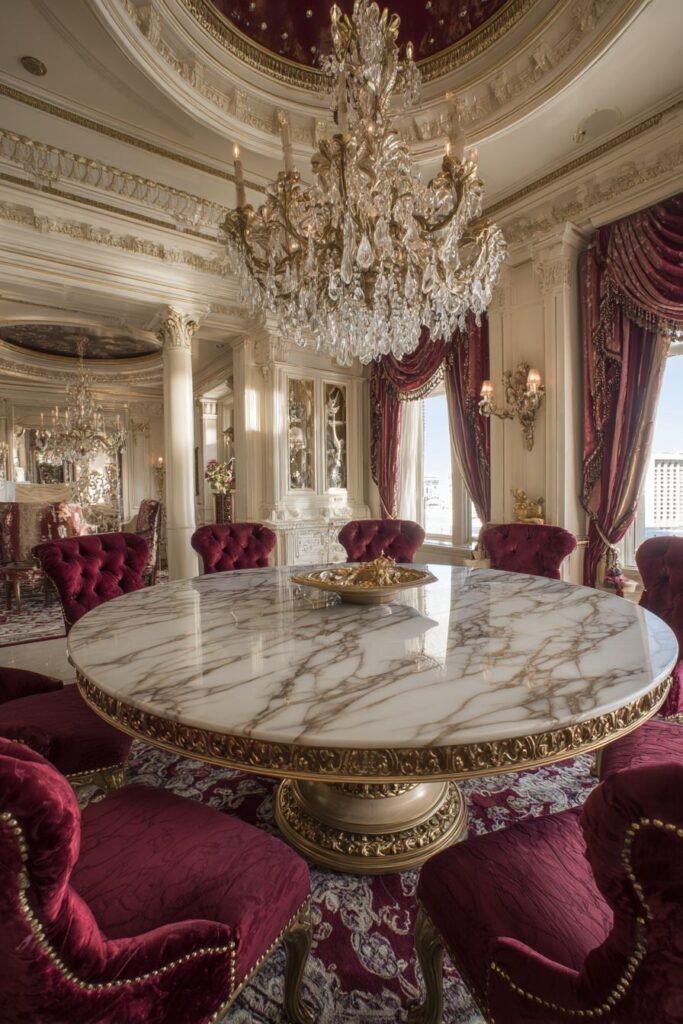
Key Design Tips:
- Choose marble with dramatic veining for natural artwork that commands attention
- Use rich burgundy leather with brass details for luxurious seating that improves with age
- Install crystal chandeliers for sparkle and traditional elegance
- Add architectural details like crown molding and coffered ceilings for grandeur
- Layer lighting sources to create sophisticated ambiance for various occasions
Why These Round Table Designs Excel
These twenty round table dining room designs represent the pinnacle of interior design excellence because they demonstrate the remarkable versatility of circular dining surfaces across every major design style and aesthetic preference. Each design showcases how round tables naturally promote conversation and intimacy while optimizing space utilization in ways that rectangular tables simply cannot match. The absence of sharp corners creates safer environments for families with children while facilitating natural traffic flow that makes spaces feel larger and more welcoming.
The material diversity represented in these designs – from reclaimed pine and live-edge oak to marble, glass, and lacquered surfaces – proves that round tables can anchor any design aesthetic from rustic farmhouse to ultra-contemporary. The pedestal base configurations eliminate the
corner leg obstacles that can limit seating flexibility with rectangular tables, allowing hosts to accommodate varying numbers of guests with ease. This adaptability makes round tables particularly valuable in modern homes where dining spaces often serve multiple functions throughout the day.
The lighting considerations in each design demonstrate how round tables create natural focal points that work beautifully with pendant lights, chandeliers, and other overhead fixtures. The circular form provides perfect symmetry for lighting placement while the absence of defined head positions means illumination can be centered for optimal coverage. This creates more even lighting distribution for dining activities while enhancing the table’s role as the room’s centerpiece.
Color theory applications across these designs show how round tables serve as neutral foundations that allow surrounding elements to shine. Whether supporting bold maximalist patterns or serene minimalist aesthetics, the circular form provides visual balance that prevents any single element from overwhelming the composition. The organic shape softens angular room architectures while creating harmony between furniture pieces and architectural elements.
The space planning advantages evident in these designs make round tables particularly valuable in today’s homes, where square footage comes at a premium. The circular configuration eliminates dead corner spaces while creating more efficient traffic patterns around the dining area. This optimization becomes especially important in open-plan living where dining areas must integrate seamlessly with the kitchen and living spaces without creating barriers or obstacles.
Cultural and historical influences represented in these designs – from French country authenticity to mid-century modern heritage – demonstrate how round tables transcend temporal and stylistic boundaries. The democratic seating arrangement has been valued across cultures and centuries, making round tables timeless choices that won’t become dated as design trends evolve. This longevity makes them wise investments for homeowners who value both style and practicality.
Conclusion
The enduring appeal of round table dining rooms lies in their unique ability to transform everyday meals into opportunities for connection and conversation. Unlike rectangular configurations that create natural hierarchies and barriers, circular arrangements democratize the dining experience while optimizing space utilization and traffic flow. These twenty design concepts demonstrate the remarkable versatility of round tables across every aesthetic preference, from minimalist Scandinavian serenity to maximalist antique opulence.
The key to successfully incorporating a round table into your dining space lies in understanding how the circular form interacts with surrounding elements. Consider the scale relationship between table diameter and room size, ensuring adequate space for comfortable seating and movement. Pay attention to lighting placement above the table, taking advantage of the natural focal point created by the circular form. Choose materials and finishes that complement your overall design aesthetic while considering the practical demands of daily use and entertaining.
Whether you’re drawn to the authentic character of reclaimed farmhouse pine, the sophisticated elegance of mahogany and crystal, or the contemporary glamour of glass and chrome, round tables offer unparalleled flexibility in creating dining spaces that reflect your personal style while promoting the intimacy and conversation that make shared meals memorable. The circular form’s organic beauty softens angular room architectures while creating natural gathering spaces that invite lingering conversations and lasting memories.
These inspiring examples prove that round table dining rooms can excel in any setting, from compact urban apartments to grand traditional homes. By embracing the unique advantages of circular dining configurations – enhanced conversation flow, optimized space utilization, democratic seating arrangements, and timeless aesthetic appeal – you can create a dining environment that serves as the true heart of your home, where family and friends naturally gather to share not just meals, but the moments that matter most.
